

quasquicentennial
[ kwos-kwi-sen-ten-ee-uh l ]
adjective: pertaining to or marking a period of 125 years.
noun: a 125th anniversary.

Pomfret campus circa 1900.
POMFRET SPIRIT
Pomfret School
398 Pomfret Street • PO Box 128 Pomfret, CT 06258-0128 860.963.6100 www.pomfret.org
Editor Garry Dow gdow@pomfret.org
Proofreaders
Tina Lefevre P ’21
Louisa Jones P ’04
Tammie LaBonte P ’05
Class Notes & Gatherings Editor Deb Thurston dthurston@pomfret.org
Designer Jordan Kempain
Contributing Writers
Tim Richards P ’15
CLASS NOTES
IN MEMORIAM
112 THE CLOCK TOWER
Contributing Photographers
Bill Gallery ’69
Jim Gipe (Pivot Media)
Jamey McSweeney
Lindsay Lehmann
Melissa J. Richards
Tie Watkins
Pomfret Magazine is published by Pomfret’s Communications Office © 2019
We Want to Hear from You Really, we do. These are your stories and this is your magazine. If we’ve inspired or challenged you, please tell us about it.
Our Mission:
Pomfret School cultivates a healthy interdependence of mind, body, and spirit in its students as it prepares them for college and to lead and learn in a diverse and increasingly interconnected society.
Pomfret School does not discriminate on the basis of race, religion, handicap, gender, sexual orientation, age, or national origin in the administration of its educational policies, admissions policies, financial aid, or other programs administered by the School.



EdwardColemanDelafeld
The First Graduate
By Tim Richards P ’15
Edward Coleman Delafield was a sixth former at Pomfret in 1894. He took nine classes that year, including two required Latin classes, two required Greek classes, and a required Sacred Study class.
Edward had a B average — pretty respectable at the time — which included As in punctuality, neatness, and behavior. He enrolled at Princeton after he graduated.
Much has changed since Edward attended Pomfret 125 years ago.
In 1894, Edward was one of forty-two students, all male, all white, and mostly from New York and New England. He was a sixth former, but might have been friends with first and second formers. The School had just six teachers. His classes were almost all pure lecture style, and he was assessed largely on how well he could memorize facts, formulas, and vocabulary. His family paid the full $600 tuition. The School had only four total buildings. He had to bring a Bible and prayer book to school, and, with no chapel on campus, he had to walk seven-tenths of a mile — each way — to an Episcopalian church every day. In the dining hall, he could choose to “eat” or “not eat” whatever was served. There were no food options. He wore a suit to class and to all meals, every day.

chapel in the heart of campus and open to people of all faiths. He would eat in a dining hall with a pizza oven, a full salad and deli bar, and a wide array of food options. He could dress in clothing of his own choice. And with multiple Cs on his transcript, it’s unlikely that he would get into Princeton. So yes, much has changed in our world and at Pomfret since 1894.
But some fundamental things have not changed at this school on the hill. Edward Delafield benefited from what was at the time state-of-the-art teaching, the most relevant curriculum, and a faculty dedicated to developing the moral character of every student. Sounds very much like Pomfret School today. We no longer give grades for punctuality, neatness, and behavior, and we don’t aim to instill, and I quote, “Christian values and manliness” in our students, which was part of the School’s mission in 1894, but we are more deeply devoted than ever before to helping our students develop the academic and moral characteristics they will need to thrive in college and in a diverse and increasingly interconnected world.
Today at Pomfret, Edward would be one of 367 students from twenty-six states and nineteen countries, including boys and girls, 14 percent of whom are students of color. He could be in class with fifty-eight different teachers. He’d take classes that are student-centered and focused less on memorization than on skills like creativity, collaboration, and critical thinking. His family would be paying $61,000 in tuition. He would have to navigate fifty buildings on campus, not four. He would not need to bring his own Episcopalian Bible or prayer book to school, and he would attend a
So while I envy having just four buildings to maintain, and I wish desperately that our tuition was still $600, I believe that Pomfret School has never been a better place to learn and grow.
I ’d like to think that Edward Delafield would still thrive at Pomfret, and I believe our founding headmaster, Mr. Peck, would be pleased to see how Pomfret’s tradition of innovation has led us to this moment.
This piece was adapted from Mr. Richards’ Convocation speech, delivered on Sunday, September 9, 2018, before an assembly of students, faculty, and parents in the du Pont Library Courtyard.
A Radical Idea
Since the very beginning, Pomfret has possessed a remarkable ability to recreate itself, again and again.

The Funder and The Founder

Most Pomfret history buffs know that William Edward Peck founded Pomfret School, but far fewer realize it was his wife, Harriet Jones Peck, who paid for it. According to their great granddaughter, Peggy Smith, Harriet inherited $10,000 from her late aunt Cornelia Torrey Faxon. Today, that sum would equal almost $250,000. This was the seed money William Peck used to start his beloved Pomfret School for Boys, as it was originally called. In addition to being the first Pomfret donor, Harriet was also an artist. In fact, the colorized portrait of William (above) was drawn by Harriet in 1889 and colorized by Lori Moser-Zaza in 2015. The picture of Harriet was drawn in 1887 by an unknown artist and colorized by Jennifer Robbins-Collins in 2015.


Motto
When William E. Peck founded Pomfret in 1894, he bequeathed to the fledgling institution a motto which has stood the test of time. The literal translation means “to strive manfully,” but since the early 1990s, the School has embraced a more equitable meaning — “to strive valiantly.” Though much has changed in 125 years, the importance of “striving” remains as relevant as ever.

Coat of Arms
Often mistaken for a griffin, the animal on Pomfret’s crest is actually a lion. The confusion can be traced all the way back to the School’s founding. Early on, Mrs. Peck thought the lion would make an excellent symbol for a boys’ school, but Mr. Peck preferred the winged griffin, the symbol on his own
Mission Statement
By one count, Pomfret has rewritten its mission statement nearly a dozen times in 125 years, roughly once a decade for the entire life of the School. It would be easy to read this statistic and intuit that the School has lacked direction. Fortunately, nothing could be further from the truth. Instead, we are a school that has always been prepared to jettison old paradigms when new ones were needed.
‘‘Our mission is to cultivate a healthy interdependence of mind, body, and spirit as we prepare our students for college, and to lead and learn in a diverse and increasingly interconnected society.”
— 2019, Mission Statement

Pomfret School
“... to afford preparationthorough for all Universities, College and Scientific Schools, and to develop in its members true manliness and Christian character.”
—1894, Mission Statement
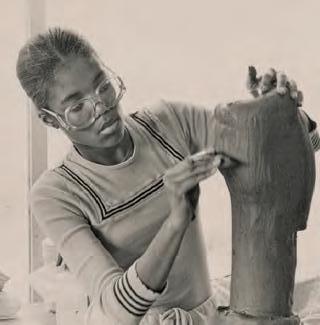


Arts at Pomfret
Of all the academic programs, perhaps none has produced so many great teachers and so many successful alumni as the arts program. Faculty like Chick Cole, Bob Sloat, Kathi Yokum, and JP Jacquet, and artists like Robert Vickrey ’44, Jack Howard-Potter ’93, Chris Rogers ’01, and Matt Lowell ’04 remind us that The Arts have (and always will be) at the center of a Pomfret education.
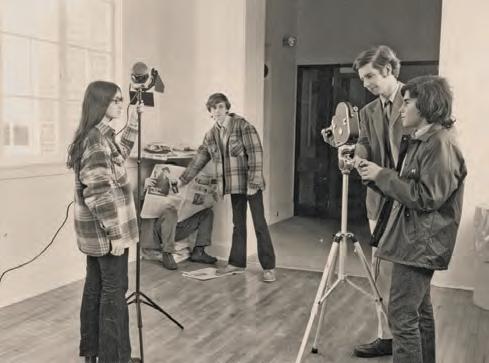


Drama, Once Upon A Mattress, 1962
Dance, 1972
Mandolin Club, 1923
Student Film, 1975
Sculpture Class, 1979
Candid Drawing, 1961
“A startlingly large number of classes believe they attended Pomfret at a unique time when fundamental change in the life of the school was occurring. All of them are probably quite right in such assessments.”
— Andrew W. Bingham ’52
First Class
The School opened on October 3, 1894 with forty-two boys and six teachers (including Peck, who taught Latin, and his brother, who taught English). Most of the boys came from New York, but several came from as far away as Ohio. Room, board, and tuition was $600, plus $30 for incidentals. Music and drawing cost extra.
A Campus of Cottages
Today, Pomfret is routinely recognized as one of the most beautiful schools in the country, but in 1906, it was still just a campus of cottages. There was not a single stone or brick building anywhere. A mere six years later, however, the campus had been utterly transformed.
The dramatic change is due in large part to the vision of Ernest Flagg, architect of the US Naval Academy, who drafted the original master plan. Between 1907 and 1912, the School erected eight new buildings. With the exception of the headmaster’s house and a couple off other inconspicuous structures, the old frame buildings had disappeared almost entirely.
“I miss them, in spite of my respectful admiration for their more efficient and solid successors,” wrote Edward Streeter (1910). “Each of those old buildings had a character of its own. The floor and stair treads creaked, but each in their own individual way. Each house had its own aroma. These are things no architect and no Board of Trustees can ever reproduce. Only the Old Timers know this and it is, perhaps, the core of their nostalgia.”
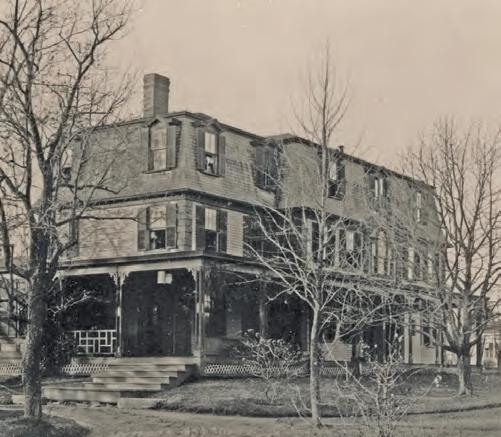
Old Main House, 1895
Making the Grade
The earliest gradebooks, like this one from 1899, recorded numerical grades for punctuality, neatness, and behavior. Today, when all of the world’s information can fit in your pocket, Pomfret is investigating new ways to measure student progress. And though letter grades are still a fact of life on the Hilltop, the day may soon come when students are judged not by what they can memorize, but by what they can do. A whole new kind of gradebook.


Stargazer


The current Olmsted Observatory is not the first telescope to scan the evening sky at Pomfret. The first observatory was taken down in 1968 to make room for the du Pont Library, and a second was dismantled in 1995 to make way for new playing fields. The current observatory was dedicated on a crisp, clear night in October 2001.
Bringing the World to Our Doorstep
Since 1989, world-renowned experts in their fields have visited Pomfret School under the auspices of the Schwartz Visiting Fellowship program. This extraordinary speaker series is the result of the vision and generosity of Michael ’66 and Eric ’69 Schwartz.
JUNOT DÍAZ 2018
ALEC ROSS 2017
PETER BERGEN 2016
CHERYL L. WEST 2015
DESTIN SANDLIN 2014
RAY SUAREZ 2013
DA CHEN 2012

CAROLYN PORCO 2011
WADE DAVIS 2010
DANA GIOIA 2009
CAROLE SIMPSON 2008
BILL BRYSON 2007
BRIAN GREENE 2006
CHRISTINE TODD WHITMAN 2005
JEAN-MICHEL COUSTEAU 2004
SERGEI KHRUSHCHEV 2003
JACQUES D’AMBOISE 2002
CARLOS FUENTES 2001
DONALD C. JOHANSON 2000
ROBERT BALLARD 1999
FRANK MCCOURT 1998
JOYCE CAROL OATES 1995
MCCULLOUGH 1994
Dr. Temple Grandin, an American professor of animal science at Colorado State University, is one of the first individuals on the autism spectrum to share insights from her personal experience with the public. In 2010, Claire Danes portrayed Grandin in the biopic film Temple Grandin. JACQUES D’AMBOISE 1996
JEHAN SADAT 1993
LEDERMAN 1992
ALBEE 1991
LEVCHENKO 1990 SHIRLEY CHISHOLM 1989
2019 Visiting Fellow
TEMPLE GRANDIN

Modern Day Wonders
The first computer science course at Pomfret didn’t actually take place at Pomfret. In response to growing student interest, teacher James McCullough began ferrying students to the University of Connecticut in 1964 so that they could take advantage of the university’s room-sized IBM 1620 Digital Computer, what the Ponty described as “this modern-day wonder.”



1937 Computer Lab, 2000s

Typewriter,






Zap Lab, 1965
Lab, 1950s
Audio Equipment, 1987
Pomfret Spirit
Innovation propels us forward, but tradition is what binds us together.
“Pomfret’s not a school. It’s an attitude — a way of thinking and living. A great big and wonderful, yet completely undefinable attitude.”
— Peter Hobbs ’61


Achaeans and Ionians
In the early 1900s, under the leadership of Headmaster William Beach Olmsted, the School began to grow at such a rapid pace that the varsity and junior varsity teams ran out of spots. In 1903, two clubs known as Achaean and Ionian were born. To keep the teams evenly balanced throughout the year, boys oftentimes switched between clubs. For example, a boy might be on the Achaean team for the football competition, but the Ionian team for baseball. This led to a lack of unity within the team, so, in 1907, a new system was adopted. If a boy joined the School as a freshman and was selected by the Ionian club, then he was to be a part of that team until he graduated.

A Banner Night, A Prize Day
For many years, on the eve of graduation, students participated in a beloved school tradition called Banner Night. The event is said to have invoked “almost pagan excitement” as they lit torches, set off fireworks, and finally gathered around a massive bonfire, before finishing up with an intense game of tug-of-war between Achaeans and Ionians.
The next day was Prize Day. Held in June, it was similar to our commencement. At a quarter before eleven, a service was held in the chapel, followed by the presentation of various awards, called prizes. Next, the School assembled in front of the sundial. The event concluded with a luncheon in the dining room.

Polar Bear Club
Though it may look like a hazing ritual to the modern eye, the Polar Bear Club was actually an exclusive social group that culminated each year with a mid-winter jump in the lake.

f re barrels ready to be lit.
Sir Galahad
To many young Pomfret students, the indomitable Sir Galahad always seemed a sixth former in armor. In truth, the actual statue is of St. George the Dragon Slayer. In later generations, students sought good luck by placing a coin in the carved marble hollow behind the kneeling knight’s head.
Bon
1960s
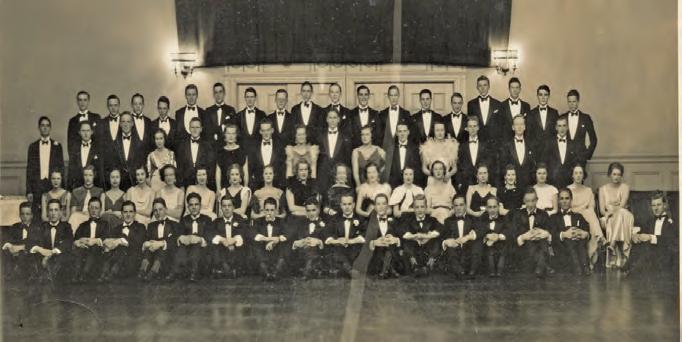

Pomfretta
During the middle part of the twentieth century, one of our most widely practiced traditions involved racing headlong down the hill in front of The Bricks after a big rainstorm. The goal was to become as muddy as possible, typically by wrestling around with friends. The activity always ended with dirty boys and big smiles. There is no evidence of when this tradition ended, but it appears to have coincided with the introduction of girls to the School.

Dances
Over the years, Pomfret has played host to a number of dances. For most of that time, these social gatherings took place in Hard Auditorium. (This was before the floor was raised and the seating became fixed.) During this period, young men would jot down the names of young women with whom they hoped to dance in little booklets like this one.

Sundial
In 1912, William Ross Proctor donated one of the School’s most iconic symbols. Proctor Sundial is a copy of the Turnbull Sundial built in 1581, which stands in the courtyard of Corpus Christi College, Oxford, England. For generations, this time-keeping monolith has represented the very essence of the School, and it is no surprise that it continues to stand at the center of our most important traditions today.
Formal, 1930s 1970s
as

in
This poster was sold
a fundraiser for prom
1986. Cynthia Carroll is top left. Jeff Lasell is top right. Will Wykcoff is bottom left. Bomber Bryan is bottom right. The girl at center is unidentifed.
Sitdown
For much of Pomfret’s history, sitdown meals happened three times a day. Faculty and their wives and children held a table, and students rotated occasionally. If you were here during that time, you probably remember with fondness this blue willow tableware, complete with personalized napkin rings.


Student Waiter, 1959




Dinner, 1967
Old Main House, 1930s
Waiter’s Table
Turning Points
Like so many of our peers, Pomfret began as an Episcopal school for boys, drawing the vast majority of its forty-two students from wealthy families in Boston and New York. Today, Pomfret serves roughly 350 students hailing from more than twenty states and just as many countries. And the scale and scope of our work on race, gender, and class has expanded to include virtually every measure of diversity — from religion and sexual orientation, to age and ability, to culture and appearance.
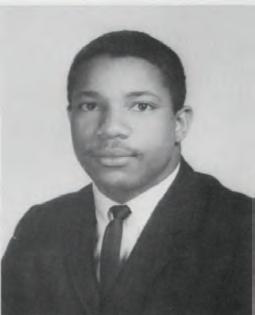
JOHN IRICK ’65
In 1964, a charismatic high school student from South Carolina named John Irick arrived at Pomfret for his senior year, becoming the first African-American to graduate from Pomfret.

NAOMI VEGA-NIEVES ’69
In 1969, Naomi Vega graduated from Pomfret, making her the first female to receive a diploma from the School. Not only was Naomi the only girl in her class, she was also the only Puerto Rican.

SCHOLARSHIPS
Pomfret has been awarding scholarships since at least the mid-1930s. In 1936, Headmaster Halleck Lefferts wrote, “Scholarship recipients make a contribution that more than offsets the aid they receive. With their various backgrounds, their seriousness of purpose, the character and leadership for which they are selected, they are necessary to the life of any well-rounded school.”

Drink ’er Down
This cartoon by Peter Arno was published by The New Yorker in 1943. When asked why he chose to highlight Pomfret in his caption, the famed cartoonist said, “It sounded appropriately stuffy.”



To Be Remembered

Loring “Ring” Bailey ’63 was from Stonington, Connecticut, and attended Pomfret in the early 1960s. Ring was a quiet kid, thin, and not particularly athletic. After Pomfret, he went to Trinity College in Connecticut, where he majored in English, and then UConn, where he studied journalism.
In the summer of 1968, Ring joined the Army and was soon shipped off to Vietnam. It was a horrible existence. To pass the time he wrote literally hundreds of pages of letters to his wife, parents, and friends back home, describing everything from the boredom of base camp to the terror of being on night patrol.
He especially wrote about his dreams for the future — traveling to Jamaica, spending Christmases with his wife, and his big dream of someday designing and building sports cars. His letters also revealed a lot of introspection about the value of the Vietnam War, as he questioned whether he and his fellow soldiers were making any sort of lasting difference. Would anyone in the future even know or care about him?
In a letter to his parents on March 14, 1970, he wrote, “To be remembered is an honor and the whole of my object.” That was his last letter. The next day, Specialist 4th Class Ring Bailey was killed by a Viet Cong booby trap, a huge mortar shell rigged as a mine. He was 24.
Go Griffins Go!
Pomfret athletics has always been about more than wins and losses.
Our Oldest Sports Photo
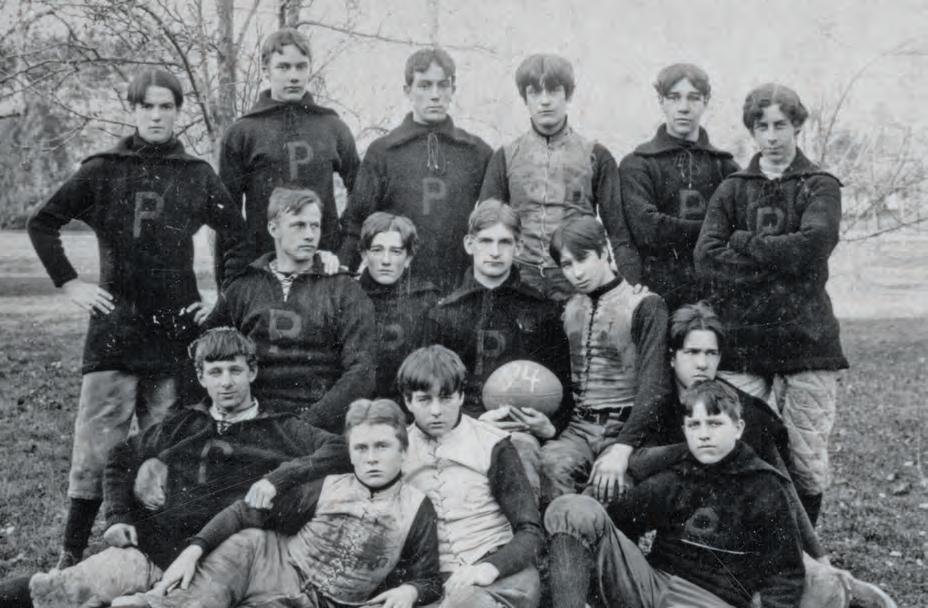


Football, 1894
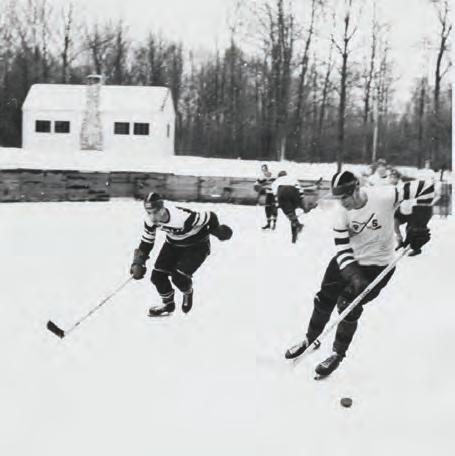

Hockey Pond
Many people still remember the old Brown Rink, named in honor of Charles Brown, a coach and athletic director from the 1920s. The rink was built in 1964, then renovated and renamed the Jahn Rink in 2005. Far fewer people remember the rink’s outdoor predecessor — a small, man-made pond that was home to Pomfret Hockey for sixty years.

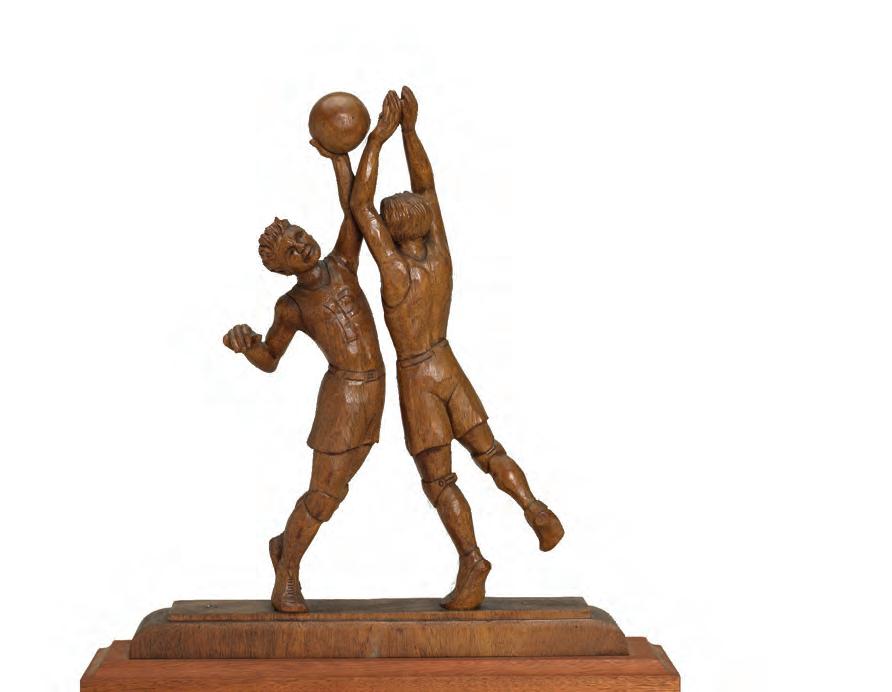
Greg Wiggins
Famed woodcarver J. Gregory Wiggins graduated from Pomfret in 1908. An uncommon man, his style reflected his own character, isolated from modern artistic movements. Wiggins was not interested in the competitive art world and instead mainly produced work for churches and schools, including a series of small wood carvings for the Pomfret Athletic Department, including this one. He died in 1956.
Hockey Pond, 1930s The Pontefract, 1942
Hockey Pond, 1950s
Football Factory
In recent years, Pomfret has gained some well-deserved notoriety for bringing 8-man football to New England, but in its heyday, the 11-man program was a nationally recognized powerhouse. Two teams, in particular, will never be forgotten: the 1917 team, which outscored its opponents 259 to 9, and the boys from 1958, who pulled off one of the greatest undefeated seasons in school history.





Charles E. “Dutch” Brown
For nearly fourteen years, Brown had been a beloved master, football coach, and athletic director. His unexpected passing — he suffered a heart attack while hiking Mt. Katahdin in 1925 at the age of 35 — sent shockwaves through the tight-knit campus community. “It is not possible within our limited space even to begin to estimate the passing from our midst of such a personality as his,” said William Beach Olmsted. “It is, however, possible to record the fact that no one who has had a part in the day’s work and the life of the School has ever left so indelible an imprint of self-sacrifice and untiring devotion.’’
Candids, 1946

Memphis Bill
William Neely Mallory, Class of 1920, was the sort of person they make movies about. Born in Memphis, Tennessee, Mal, as his friends called him, was the football team’s star halfback, and a savage tackler on defense. In baseball he was a catcher, and with his strong arm he’d throw out anyone trying to steal a base. In winter, he was the hockey team’s captain.
Besides being a good athlete, Mal was a respected leader. He was the president of his class as a sophomore, junior, and senior; a member of the theater group; and the yearbook’s editor-in-chief.
Af ter high school, he went on to Yale, where he continued his athletic success. In those days, the best football teams in the country were in the Ivy League. Mallory was captain of Yale’s undefeated 1923 football team and was named an All-American. Today, almost a century later, every year at Yale’s graduation, the best male athlete in the class receives an award called the Mallory trophy.
Af ter finishing college in 1924, Mallory moved back to Memphis and successfully built up the family business. Although Mal was already 40 years old when the Japanese attacked Pearl Harbor, he enlisted in the Army Air Corps.
In February 1945, his time overseas was up, and he prepared to return to the US. On February 19, a day when heavy clouds and bad weather had grounded the bombers, Mallory’s transport plane left southern Italy for London, where he was to board a ship headed home. But he never made it back to Memphis. Major Neely Mallory, age 43, was killed that foggy day when his plane crashed into a mountainside in Italy. He left behind a wife and a 10-year-old son.




A sampling of Pomfret athletic gear from across the decades.


William Mallory (1920) was the ultimate big man on campus, pictured here in his hockey gear.

Girl Time

In 1972, Title IX ushered in the first wave of interscholastic athletics for girls at Pomfret. Among the first sports to be adopted was soccer. “I was playing field hockey for Bancroft at the time,” remembers Louisa Jones ’P 04, “and when the field hockey season was over, we turned into the soccer team, just so Pomfret would have some girls to play against.”


Lewis Gymnasium
Long before Corzine Athletic Center there was Lewis Gymnasium, now home to the Olmsted Student Union. The original building was built in 1917, a gift of the Lewis family to the School. The main floor was reserved for rings, parallel bars, stationary bicycles, and a basketball court. The upper floor contained a running track and two large trophy rooms. The bottom level housed squash courts; rooms for wrestling, boxing, and rowing; and lockers and showers.

1980s


Into the Wild
Pomfret has always loved the thrill of interscholastic competition, but we have also valued the skills, life lessons, and health benefits of outdoor activity. Whether it was skiing, cycling, canoeing, horseback riding, or rock climbing Pomfret students have always had a taste for adventure.
Long Overdue
Going back to almost the very beginning, our boys and girls have plied the placid waters of the Quiet Corner. But it took nearly a century before crew had a home.
S peaking at the christening of the Blodgett Boathouse in 2006, Mark Blodgett ’75 said, “I called up the director of development and suggested that a boathouse was long overdue. After all, I think that 100 years is a long time to wait for a home… and almost one year to the day, I am flabbergasted to say that this boathouse is a reality.”

Cycling, 1989
Boats and Skis, 1954

The Pontefract, 1962


Griffin Pride
From pep rallies and bonfires to color tosses and blackout games, Pomfret students have always shown up to support their team.


The World According To Hagop
Pomfret Wrestling began sometime in the early twentieth century and continued for many years, in fits and starts, until the winter of 1955-56, when Doug McLure and George Campbell started the modern program. Several years later, in 1961, Hagop Merjian joined the coaching staff and everything changed. “We soon learned that life would never be the same,” said Wally Buschmann ’62. “We were entering The World According to Hagop.”

A WORLD OF

REMARKABLE GRIFFINS
The number of Griffins who have made their mark on the world is staggering. Take Jon Stone ’48, the co-creator of Sesame Street. Or Thomas Garrison ’96, a National Geographic explorer. Or Felice Mueller ’08, an Olympic rower. Or Chelsea Cutler ’15, a singer-songwriter with over 30 million streams on Spotify. Remarkable people. Remarkable achievements.
In celebr ation of Pomfret’s 125th anniversary, we are shining a light on these difference makers — 125 individuals who represent the best of what it means to be a Griffin. This assemblage includes Nobel laureates and Oscar winners, industry titans
and government officials, artists and athletes, activists and entrepreneurs. It also includes a number of people who are harder to label but no less extraordinary — people leading lives full of passion, courage, wit, wisdom, creativity, and grace.
Of course, for every remarkable Griffin who made the list, there are hundreds more who deserved to. It would have been impossible to take the full measure of them all. As with any ranking, this exercise was far more art than science, and we’d love to hear what you think.
And now, on to the list.

DIFFERENCE
CAROLINE WATERLOW ’91
An Emmy Award-winning producer, Caroline is best known for her film OJ: Made in America, which won the Oscar for Best Documentary Feature in 2017. “You can do it,” she says. “You just need the confidence to know you will figure things out. You can take on a lot more than you think.”
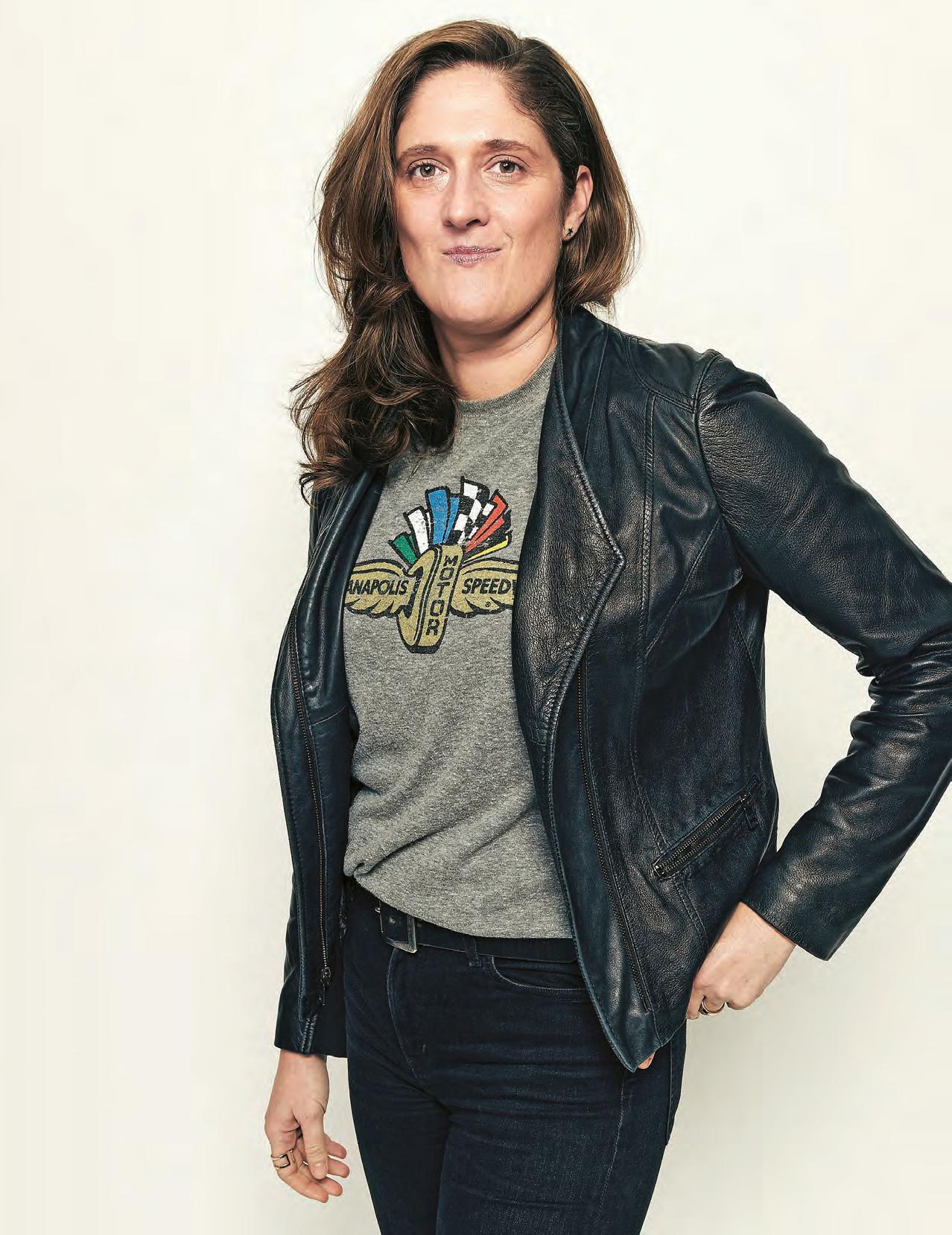
MEDIA AND ENTERTAINMENT
EDWARD STREETER (1910)
Author of Father of the Bride.
ROGER ANGELL ’38
Former chief fiction editor of The New Yorker, best known for his baseball essays.
EMERSON STONE ’45
Former CBS news executive and two-time Peabody Award winner.
JAMES GOODALE ’51
Former vice president and general counsel for The New York Times.
ADAM HOCHSCHILD ’60
Founder of Mother Jones magazine and author of the best-selling book King Leopold’s Ghost.
JACK VIERTEL ’67
Broadway producer of plays like Tony Kushner’s Angels in America.
RIDLEY PEARSON ’71
New York Times best-selling co-author of the Peter & The Starcatchers series.

ALEX GIBNEY ’71
Oscar-winning filmmaker who has been called “the most important documentarian of our time.”
EBEN OSTBY ’73
Founding staff member of Pixar Animation Studios and a pioneer in the field of computer graphics.
PERLA FARIAS ’80
Venezuelan writer, director, and producer. Executive at Telemundo.
JON STONE ’48
Regarded by many as the best children's writer in the history of television, Jon was an awardwinning writer, director, and producer. He is best known as the co-creator of Sesame Street, where he developed characters such as Cookie Monster, Oscar the Grouch, and Big Bird with Jim Henson. Stone won eighteen television Emmy Awards.
QUINN ELI ’80
Author of African American literature.
JOSH BANK ’86
The man behind television hits like Gossip Girl, Pretty Little Liars, and Vampire Diaries.
MATHER ZICKEL ’88
Film actor who has appeared in movies like Rachel Getting Married and I Love
You Man.
LORENZO BORGHESE ’91
Reality television star, entrepreneur, and animal rights advocate.

MALIK DUCARD ’91
Malik is vice president of content partnerships at YouTube, overseeing business development efforts for the platform’s learning, social impact, family, film, and television partnership areas. He is also author of Henry's Big Win, winner of the Jessie Redmon Fauset Award for Best Children’s Book.

BILL ARMY ’03
Bill is a Broadway actor best known for his role as Zelger in the Tony Award-winning musical The Band’s Visit. Writing in NewYorkMagazine, Sara Holdren said, “This show gave me more hope for what Broadway might welcome, might foster, might become, than any musical in a long time.”
JOE MATHIEU ’92
Anchor and executive editor of WGBH Radio’s Morning Edition.
MARIANA BLACK ROGERINO ’02
Creative Director at HBO.
SPENCER BAILEY ’04
Editor-at-large of the book publisher Phaidon, a contributing editor at Town & Country, and the creator of the podcast Time Sensitive.

FRANCES (LUMPKIN) ’91 AND DEACON ’91 WEBSTER
The husband-and-wife team behind Walrus, a New York City advertising firm. Since its founding in 2005, Walrus has quickly become one of the most soughtafter ad agencies in New York — launching products, planning stunts, and developing content for brands such as Amazon, History Channel, Comedy Central, Staples, Emergen-C, The Economist, HBO, Wired, and Grand Marnier.


BUSINESS, GOVERNMENT, MEDICINE, AND LAW
HERBERT CLAIBORNE PELL, JR. (1902)
United States representative from New York, US minister to Portugal and Hungary, and a member of the United Nations War Crimes Commission.
ARTHUR PURDY STOUT (1903)
Noted surgeon and pathologist.
ROBERT FISKE ’48
Prominent trial attorney and special prosecutor during Whitewater.
WILLIAM POLK CAREY ’48
American philanthropist and businessman who endowed the W.P. Carey ’48 College Admission Lecture Series at Pomfret.
EDWARD DU PONT ’52
Noted philanthropist who worked for the Wilmington Trust Company (1968–1985) and served as the lead donor on Pomfret’s Henry B. du Pont ’16 Library.

GIFFORD PINCHOT ’60
Advocate for sustainable business practices and grandson of the first chief of the US Forest Service.
GÖTZ SCHREIBER ’63
Former principal economist at the World Bank.
PAUL FOWLER ’64
Marketing guru at Pepsi.
EDWARD STETTINIUS JR. (1920)
Edward Stettinius Jr. was an American businessman who served as secretary of state under Presidents Franklin D. Roosevelt and Harry S. Truman, and as US ambassador to the United Nations.
ERIC COLEMAN ’69
A former representative who served for more than twenty years in the Connecticut state legislature, Eric recently became a Superior Court judge. “Talk about a class act,“ said Senator L. Scott Frantz, a Greenwich Republican. “He is just as good as they come.“


ROB HUNTER ’78
A longtime Napa Valley vintner, Rob has recently trained his considerable talents on cheese-making.
FRANK PAINE ’64
Former senior bank examiner at the Federal Reserve Bank of New York.
BUZZ YUDELL ’65
Noted pioneer of planning and architecture for sustainable communities.
DERRY ALLEN ’65
Longtime civil servant with the US Environmental Protection Agency.
ANTÔNIO AUGUSTO CANÇADO TRINDADE ’66
Brazilian judge on the International Court of Justice (The Hague).
DAVID HALL ’70
Pioneer in the field of self-driving car technology.
SOOHO CHO ’74
Former Chairman and CEO of Hanjin Shipping and the former Director of Korean Airlines.
TEO HENRIQUEZ ’75 Immigration lawyer.

DON WILLIAMS ’75
Former president pro tempore of the Connecticut senate.
PAUL CALLAHAN ’76
CEO of Sail to Prevail, a nonprofit adaptive sailing program in Newport, RI.
JAMES SNYDER ’82
Systems administrator at the US Library of Congress.
WHITNEY WELCH ’82 Firefighter.
PEYTON (LADT) STERNS ’03
Peyton is the co-founder and CEO of Bashed, an online destination that allows diners to search and instantly reserve venues in New York City for private dinners and group events. Through her Tastemaker Talks and Peyton Tries blogs, she is quickly becoming the go-to source for all things hosting and entertaining.
ERIC KAPITULIK ’90
Former platoon commander US Marine Corps Special Forces.
ELIZABETH (JENKINS) BRETSCHGER ’93
Founder of Elizabeth McKay, a women’s luxury lifestyle apparel company.
HELMUT JAHN P ’97
A Chicago-based German-American architect with offices in Berlin and Shanghai who designed Pomfret’s Jahn Rink.
KIP HALE ’98

Lawyer who focuses on atrocity crimes in conflict zones.
VINCENT CAPALDI ’99
Psychiatrist at Walter Reed National Military Medical Center.
BENNETT KONESNI ’00
Co-founder of Sylvester Manor Educational Farm on Shelter Island, NY.
JON CORZINE P ’02
United States senator from New Jersey (2001–2006) and the 54th Governor of New Jersey (2006–2010). Helped fund the Corzine Athletic Center with his wife, Joanne.
PETER OLIVETTI ’95
The man behind Olivetti Bicycles in cyclehappy Boulder, CO, Peter is a master framebuilder with a reputation for crafting go-anywhere, multi-surface adventure bikes perfectly suited for the rugged terrain surrounding his rustic shop on the front range of The Rockies.
HILLARY (ROSS) CHARALAMBOUS ’06
Hillary is a commissioned officer and helicopter pilot for the US Navy, and a graduate of the US Naval Academy in Annapolis, Maryland. Her first duty station was Norfolk, Virginia, at Helicopter Sea Combat Squadron (HSC) 26, where she deployed twice to Bahrain in support of the Navy’s Fifth Fleet Command. Hillary has flown nearly 1000 flight hours in her career.

AZIZ AHMED ’02
Emergency care physician at New York Presbyterian Hospital.
PETER GRAUER P ’02, ’10
Businessman and entrepreneur who succeeded Michael Bloomberg as chairman of Bloomberg L.P. in 2001. With his wife Laurie, he established Pomfret’s Grauer Family Institute in 2014.
JENNIE BELLONIO ’06
US Marine Corps captain.
CLAIRE RIMKUS ’06
Forensic scientist at the Massachusetts State Police Crime Laboratory.
BEN TARLOW ’08
Owner of Mid-Century Motoring, a classic and exotic car showroom and brokerage.
NICOLE SHIRLEY ’08
Marketing director at L’Oréal.
ZENAB KEITA ’10
Partnership development manager with the Golden State Warriors.
MEG GAUDREAU ’12
Business owner connecting college basketball players with service work in South Africa.
MATT SCANLAN ’07
In 2015, Matt Scanlan packed $2.5 million into 32 plastic bags, piled them into the back of a rented Land Cruiser, and headed for the Gobi Desert. Named to the Forbes 30 under 30 list for 2018, Matt is the co-founder and CEO of Naadam Cashmere, a socially-conscious brand that has transformed the cashmere supply chain. “We’re disrupting a thousandyear-old business model by purchasing wool directly from herders at fair prices,” he says.

ARTS AND ACADEMICS
WILLIAM F. DRAPER ’31
Combat artist and prominent portrait painter of US presidents and other notables.
CORNELIUS VERMEULE III ’43
Scholar of ancient art and curator of classical art at the Museum of Fine Arts, Boston (1957 to 1996).
ROBERT VICKREY ’44
World-famous painter who led the magic realism movement.
RICHARD ESTES ’46
Behavioral zoologist and ecologist.
THEODORE SIZER ’49
Noted educational reformer and former dean of the Harvard Graduate School of Education.
PETER HOWARD ’50
Principal cellist of the Saint Paul Chamber Orchestra for twenty-nine years.
PETER BEARD ’56
Celebrated photographer and diarist.
ORVILLE SCHELL ’58
Writer, academic, and activist, well known for his works on China.
JOE BOYD ’60
Record producer and author who has worked the likes of Pink Floyd, Richard Thompson, Nick Drake, R.E.M., and 10,000 Maniacs.
JOHN BOCKSTOCE ’62
Arctic historian and archaeologist.
PETER CORBIN ’64
One of the foremost sporting artists in America.
W. MEREDITH BACON ’64
Political science professor and LGBTQ activist.

JEFF HOPKINS ’58
Jeff is an American Tibetologist who has authored more than twenty-five books about Tibetan Buddhism, among them the highly influential Meditation on Emptiness. From 1979 to 1989, he was the Dalai Lama's chief English interpreter, and played a significant role in the development of the Free Tibet Movement.

CHRIS ROGERS ’01
Chris is an acclaimed street artist living in Austin, Texas, known for his murals, portraiture, abstract, and representational work.
JACK HARDY ’65
Influential Greenwich Village folk musician.
JACK HOWARD-POTTER ’93
Sculptor who works with steel to create large-scale figurative forms.
MATT LOWELL ’04
Frontman for the indie rock band Lo Moon.
AUSTIN HOAG ’08
Research scientist in astrophysics.

JAMES ROTHMAN ’67
In 2013, James Rothman won a Nobel Prize for helping to decipher the basic machinery of cellular life. Today, he is the Fergus F. Wallace Professor of Biomedical Sciences at Yale University, chairman of the Department of Cell Biology at Yale School of Medicine, and director of the Nanobiology Institute at the Yale West Campus.

THOMAS GARRISON ’96
Our very own Indiana Jones, Tom is a Maya archaeologist, Ithaca College professor, and National Geographic Explorer. He is worldrenowned for his pioneering work using LiDar technology to reveal hidden ruins buried beneath large swaths of the Guatemalan jungle.

CHELSEA CUTLER ’15
At only 22 years old, Chelsea is already a star. The singer, songwriter, and producer has over 30 million streams on Spotify.


BESENIA RODRIGUEZ ’96
Besenia is the senior associate dean of curriculum at Brown University, where she oversees course proposal and concentration reviews, global experiential learning, and curriculum development and assessment. Originally from the South Bronx, she was the first in her family to attend college. “At Pomfret, I learned to ask questions, to make mistakes, to ask for help, and to listen to my own voice,” she says.
ATHLETICS AND ENDURANCE
CHARLIE BUELL (1918)
All-American Harvard quarterback who revolutionized football by making the pass an offensive weapon.
PETER DALAND ’39
Olympic swim coach and a member of the International Swimming Hall of Fame.
KENYON CLARK ’67
Tennis pro who coached former top-10 women’s tour player Barbara Potter when she was a teen.
DAVID ROSEN ’73
Adaptive rower who has competed on some of rowing’s biggest stages.
JOEY MOFFITT ’82
Sailor and consultant to US Olympic and Paralympic Sailing.
KAY COWPERTHWAIT ’87
Former head coach for lacrosse at Stanford and hockey at Amherst.

WALLY GOODWIN ’45
Wally is the longtime Stanford golf coach who famously recruited Tiger Woods when he was only 13 years old. Wally won the national championship in 1994.
TOM SPERRY ’91
Tom is an extreme ultramarathoner who races in some of the world’s most hostile environments. He has twice competed in a 250-kilometer race across the African desert. “Basically, your body breaks down and it becomes a race of suffering and your willingness to keep going,” he says. “It becomes a race of mind and spirit and heart. You really dig deep and focus on what and who is important to you. It is really an amazing thing to experience and very hard to describe.”



HUNTER TEMPLE ’53
Hunter is a six-time Ironman competitor who is still racing as an octogenarian. Among his many accomplishments, Temple has qualified for the Ford Ironman World Championship four times since 1985. During his third Ironman World Championship in 2010, he crashed 90 miles into the 112-mile bike ride, suffering a fractured hip. Despite his injuries, he peddled the remaining twenty-two miles before medics forcibly removed him from the race. Following the crash, he underwent hipreplacement surgery and was told he would never run again. Two years later, he defied the odds by returning to the Ironman circuit and has never looked back.
Ironman

FELICE MUELLER ’08
Felice won a gold medal in the coxless four at the 2013 World Rowing Championships, finished fourth at the 2016 Olympic games in Rio de Janeiro, and took bronze in the 2019 World Rowing Cup in Bulgaria.
BOBBY VEGA ’01
Bobby is an NFL scout for the Baltimore Ravens. Before joining Baltimore, he spent thirteen years with the Browns.

SARAH VAILLANCOURT ’04
Sarah is a two-time Olympic gold medalist in ice hockey. A member of the Canadian women’s national team, Vaillancourt has played in nearly 100 international games, scoring more than thirty goals. At Harvard, she was ranked fourth overall in the NCAA.
MICAELA LONG ’06
Micaela is a pro hockey player for the Connecticut Whale. A former member of the Boston Blades, she played her D1 hockey at the University of New Hampshire.
BRIAN FLYNN ’07
After a standout career as the captain of the University of Maine Black Bears, Brian made his NHL debut in 2013. A native of Boston, MA, he has played for several NHL clubs, including the Buffalo Sabers and Montreal Canadiens.

JAIMIE LEONOFF ’11
Jaimie was one of only two goaltenders selected to play in the first NWHL All-Star Game as a member of the Connecticut Whale. She was also a record-setting goalkeeper for the Yale Bulldogs.
HEADMASTERS, FACULTY, AND STAFF
DAVID TWICHELL P ’67
Revolutionary headmaster and nationally recognized educational reformer.
PER-JAN RANHOFF P ’80, ’83
Math teacher, assistant headmaster, and interim headmaster.
JAY MILNOR P ’74
Headmaster known for his strong sense of community.
BRAD HASTINGS ’68, P ’98, ’01
Athletic director, admissions officer, and headmaster who guided the School into a new century.

WILLIAM E. PECK
For twenty-three years, William E. Peck was a member of the faculty at St. Mark’s in Southborough, MA. By the time his progressive tendencies came into conflict with the more traditional views of the board, he had risen all the way to the role of headmaster. In 1893, he left St. Mark’s behind to found a school of his own. The rest, as they say, is history.
WILLIAM
“BULL” OLMSTED
Though no building bears his name, Olmsted was the driving force at Pomfret for an astounding thirtythree years. At the time of his death, he and the School had attained such stature that his obituary was published in Time magazine.


BRENDA HART
Hired by Kenneth Deitch in 1975, Brenda worked for six different headmasters. “If anyone deserves to retire it is Brenda,“ said Tim Richards in 2014. “Her nearly 40 years of service to Pomfret School students, headmasters, and faculty have been distinguished by good humor, outstanding work ethic, careful attention to detail, graciousness in the midst of every situation, wisdom, and compassion. We will miss her.“

Pomfret Road
Route 44 has seen many great faculty, but perhaps none greater than these four. Walt, Jim, Waddy, and Kathi personify what it means to give of yourself freely and without restriction.
WALT HINCHMAN Science teacher.
JIM REES French teacher.
WADDY ROWE English teacher.
KATHI YOKUM Ceramics teacher.
BOB SLOAT P ’86, ’95
During his storied forty-one-year career, Bob held many positions, including math teacher and chair of the Fine Arts Department. But it was his deep and abiding passion for theater that defined him. By the time Bob retired in 2006, he had participated in the development of more than 200 dramatic performances, including what he considered his two standout school productions, Cats and The Diary of Anne Frank. “Making theater happen is what I really love doing,“ he once said.
CHARLES E. “DUTCH” BROWN Athletic director.
MANNIE MANSFIELD ’48 Athletic director.
WYATT GARFIELD ’43 English teacher.
WARREN GEISSINGER P ’72, ’74, ’76 Music teacher.

ALICE DUNBAR Ceramics teacher.
GINNY AND MARSHALL EATON P ’91 VOICE advisors.
BEN MORGAN ’53 Science teacher.
HAGOP MERJIAN P ’80, ’82, ’92 English teacher.

ARTHUR DIAZ ’78, P ’10, ’12, ’14 Chief financial officer.
DICK FLOOD French teacher.
MAY COTTER Cook remembered for her famous dough balls.
MARCIA “MA B” BIRDSALL P ’77, ’78 School secretary.
CHICK COLE P ’71, ’72, ’75, ’81
Chick served on the Pomfret faculty for forty-seven years and lived next door for another eighteen. When he retired from Pomfret is 1998, his friend and colleague Hagop Merjian wrote: “He enjoined me, he entreated me, he urged me with a true and striking compassion... this manner of instant human empathy is what makes Chick leap, in my mind, into the pantheon of special human beings.“

THE UNBROKEN LINE:
A Brief History of Pomfret
For thousands of years, the vast stretch of lushly wooded, rolling hills we now call Pomfret was home to two Native American tribes, the Nipmuck and the Narragansett, who claimed opposite sides of the Quinebaug River. They called the valley Mashamoquet, or “at the great fishing place.” Eventually these two groups were succeeded by the Pequots, and in 1684, the Sachem Owaneco gave Major James Fitch a title to the area. Two years later, in 1686, Fitch sold 15,000 acres, encompassing the entirety of modern day Pomfret School, to twelve settlers for thirty pounds. Forty families soon joined the original twelve settlers, and, in 1713, the area was incorporated by the General Court of Connecticut under the name Pomfret, named after an English manor, presided over by the Lord of Pomfret. For the next 181 years, descendants of those first families added homes, farms, and inns to the top of Pomfret Hill, setting the stage for the arrival of a charismatic teacher looking for a place to start a school of his own.


The Founding 1894 - 1897
William E. Peck was a member of the faculty at St. Mark’s in Southborough, Massachusetts, for twenty-three years. By the time his more progressive tendencies came into conflict with the school, he had risen all the way to the role of headmaster. Rather than submit, he resigned. With his wife, Harriet, he purchased the Charles Grosvenor Inn. On October 3, 1894, Pomfret School was born.
Peck’s personal reputation and charisma, paired with his ability to engender confidence, contributed to the success of the new undertaking from the very start. By the beginning of the 1896-1897 school year, Pomfret had doubled in size, growing from forty-two to eighty students and from six to eleven faculty members. During those early years, the Pecks lived in one of the cottages attached to the inn. A single building (the first “main house”) housed the dormitory, classrooms, and dining hall, and a nearby stable served as the first gymnasium.
Tragically, during the winter of that year, an epidemic of bronchitis and pneumonia struck the School. Peck caught a particularly virulent strain of the disease, possibly from a sick young student whom he had carried in his arms to the infirmary. He died on January 7, 1897. His death marked the end of the first, short era in Pomfret’s history.
William E. Peck


Construction Ben Grosvenor Inn
Period of Growth 1897 - 1929
William “Bull” Olmsted served as Pomfret’s headmaster from 1897 until his death in 1929, making him the longest serving headmaster in Pomfret history. During his thirty-two years, he presided over the acquisition and creation of no fewer than a dozen landmark buildings, as well as hundreds of acres of land.
In 1905, the School hired Ernest Flagg, an architect of the US Naval Academy, to draft a master plan. Over the next ten years, Flagg would go on to design and build most of the campus core, including the School Building, the Bricks, Pyne Infirmary, Clark Memorial Chapel, and Lewis Gymnasium.
In those interceding decades, Pomfret grew not only in terms of bricks and mortar, but also in terms of enrollment and endowment. It was also a time of great athletic prowess with successful football, baseball, and ice hockey teams. Mr. Olmsted was on the field every day and demanded the same rigorous approach to athletics as he did to academics.
On October 24, 1929, a date that would come to be known as Black Thursday, the stock market crashed, creating a decade-long depression that affected most of Pomfret’s families. Later that year, Mr. Olmsted died and was buried in the crypt beneath Clark Memorial Chapel. At the time of his death, he and the School had attained such stature that his obituary was published in Time magazine.
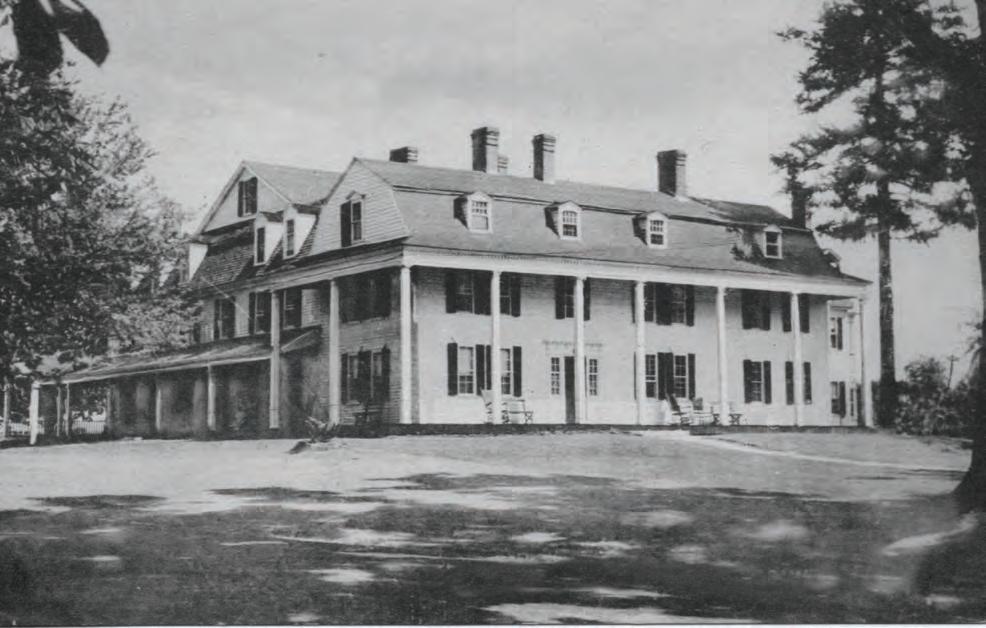
Hard Times
1930 - 1951
Halleck Lefferts was the third headmaster of Pomfret School. Educated at Yale, he came from the Thacher School in Ojai, California, just as Pomfret was beginning to feel the full impact of the Depression. In 1931, the School’s treasurer announced that Pomfret would likely operate at a loss. By 1934, many families could no longer
Faces of Change 1951 - 1973
In the fall of 1951, David Twichell took the reins as Pomfret’s newest headmaster, and continued to guide the School — often through uncharted territory — for the next decade. Writing in the New York Herald Tribune in 1956, Al Laney penned a glowing review of Pomfret. Of the transitional, innovative character of Mr. Twichell’s tenure, he wrote: “Pomfret is surely unique in its headmaster, for there is hardly another such as David Cushman Twichell, who has quite unusual ideas and has done quite unusual things in his five- or six-year headmastership.”
Another product of Thacher School, Mr. Twichell was an idealist in every sense of the word. He believed in and trusted his students, and felt that the School would be better if it were more flexible, rather than less flexible. Under his leadership, two new buildings opened: the current Main House in 1956 and the Monell Science Building in 1958. By the time he resigned in April of 1961, Twichell had transformed Pomfret into one of the most progressive boarding schools in the country.
In the fall of 1961, just as the Vietnam War was heating up, Joseph Milnor became Pomfret’s sixth headmaster. Three years later, in 1964, one of the most significant events in Pomfret history would occur when John Irick, a charismatic high school student from Orangeburg, South Carolina, arrived at Pomfret for his senior year. He would go on to become the first African-American to graduate from Pomfret.
Four years later, in February of 1968, The Pontefract bannered the news that “to the joy of most, and the unhappiness of a few,” the board of directors had voted to admit female day students beginning the following fall. In the spring of 1973, Milnor retired from Pomfret School, leaving an indelible mark on the social fabric and political consciousness of the School.

afford to send their sons away to boarding school, leading to a pronounced decline in enrollment.
Despite the financial troubles of the 1930s, the School continued to move forward. It was during this difficult time that biology, chemistry, and drawing were added to the curriculum; basketball and crew were added to the athletic program; and the faculty advisor-advisee system, which continues to this day, was introduced. With the war looming, Lefferts resigned in June of 1942 to fight with the Army, and was replaced by Dexter Strong, who had also taught at Thacher.
W ith Strong at the helm, the School purchased the Ben Grosvenor Inn, adding 289 acres to the campus,

including a magnificent well, which remains the source of the School’s water to this day. Due in large part to the creation of a regional scholarship program, enrollment soared during this period of time. In the fall of 1948, the School opened with 151 students, the largest enrollment in its history. They came from 11 states, the District of Columbia, 1 territory, and 4 foreign countries. Under the guidance of Lefferts and Strong, Pomfret had successfully weathered two of the most difficult periods of the twentieth century, the Great Depression and World War II.

Mashamoquet Day

Struggle for Survival 1973 -
1979
As the 1970s wore on, financial trouble returned to the Hilltop. It would fall to 34-year-old Kenneth Deitch, an assistant professor of economics from Harvard, to guide the School through its darkest days. Deitch quickly set to work, raising money and cutting costs wherever he could, including a freeze on faculty salaries. It made him the enemy of many, but probably saved the School.
Besides the budget, Deitch also ran into opposition when he rejected the recommendations of the Curriculum Committee’s final report, which had been developed but not implemented toward the end of Milnor era. In a sense, he was rejecting twenty years of innovation and experimentation first introduced by David Twichell in the early 1950s. After three tumultuous but critically important years, Deitch left Pomfret in 1976. The School was bruised, but it had survived.
That spring marked a turning point. Still struggling through the worst financial crisis in eighty years, Pomfret turned to Assistant Headmaster Per-Jan Ranhoff for temporary stability. For the next six months, Ranhoff guided the School while the search committee looked for a new headmaster.
Almost immediately, they landed on the Reverend Burton A. MacLean. Over the next several years, MacLean offered a steady hand as the School slowly but surely turned itself around. In 1977, the key to the School’s financial recovery finally arrived. Called the Promise to Prosperity, the $2.5 million fundraising campaign aimed to improve the physical plant, erase the School’s debts, and bolster the endowment. By the end of 1979, MacLean (ably assisted by Ranhoff) had succeeded. The Pomfret community would finally be able to breathe a sigh of relief, as the turbulent times of the 1970s became an increasingly distant memory.


“...how lucky we are to be here.”
The Spirit of Pomfret 1979 - 1989
Pomfret is known for its strong sense of community, and no one deserves more credit for cultivating that sense of community than Gerrit Keator and his wife, Marnie, who arrived on the Hilltop in 1979.
“Both Gerrit and I felt that a boarding school should have a warm, happy, and loving atmosphere,” Mrs. Keator said. “Therefore, I felt that my role was to be primarily an extension of my role in my own family, i.e., Chairman of the Tender Loving Care Department.”
Under the Keator family’s charismatic leadership, enrollment continued to rise. In 1980, the School opened its doors with 297 students (232 boarders and 65 day students), the most ever. When questioned, most students felt the School had improved dramatically. In general, there was better communication and more friendship between students and faculty, even as the level of academic rigor continued to rise.
The mid-1980s also marked the introduction of two important changes to campus life. First, Keator made chapel mandatory, restoring a sense of spiritual heritage to the School. Second, he began offering teachers the funds to further their education, going so far as to offer a full-year, paid sabbatical to veteran teachers.
By the time Keator entered his final year as headmaster, morale was at an all-time high and Pomfret had regained its reputation as one of the best, small independent schools in the country. “Lately I’ve noticed something about our school and everyone here,” said senior Cara Landi in 1989. “A spirit seems to be surging throughout our campus. Think about how lucky we are to be here.”
Centennial Architectural Rendering

Breaking New Ground
1989 - 2011
When asked why he accepted the headmaster position at Pomfret, Patrick Bassett gave three reasons: the sylvan splendor of its location; its commitment to students’ intellect, creative spirit, and athletic nature; and the feeling of friendliness and happiness he felt visiting the School.
As it turned out, his greatest and most lasting achievement would have less to do with what attracted him to Pomfret and more to do with what he felt could be improved. Not long after his arrival, Bassett quickly appointed the School’s first dean of women “to be an instigator for raising the consciousness of women’s issues.”
Around the same time, he authorized the formation of a chapter of the Council for Women in Independent Schools, with the expressed intent of furthering the development of the females who studied, lived, and worked at Pomfret.
In September of 1993, Bradford Hastings ’68 was appointed Pomfret’s eleventh headmaster. Perhaps no headmaster since Olmsted has so fully transformed the

Hilltop. He had previously served on the faculty as a history teacher, director of athletics, and assistant director of admissions, as well as a trustee. “I want the school to increase its confidence in itself,” he said. “We should dare to do things it never tried . . . not just go along.”
D uring his nearly two-decade run, Hastings oversaw the construction of a myriad of buildings, including Corzine Athletic Center, Olmsted Student Union, Blodgett Boathouse, Lasell Alumni House, Jahn Rink, Blodgett Tennis Center, and Olmsted Observatory. The campus and the community would never be the same. Another major improvement was the establishment of a new central power plant, which greatly reduced the School’s carbon emissions, while saving thousands of dollars in annual fuel costs. By the end of his long tenure — the second longest in school history — Hastings had safely steered the School into the twenty-first century.

A Reflection of the World

The Future
2011 -
In 2011, J. Timothy Richards P ’15, a graduate of Phillips Andover and a long-time faculty member at St. George’s School, was appointed Pomfret’s twelfth Head of School. Richards’ arrival has heralded a new approach to teaching and learning at Pomfret. “If the next generation is to flourish in a changing world,” he says, “we must prepare them wisely, differently, and well.”
In 2013, the School launched its vision for the future: The Pomfret Purpose. Among the four goals outlined in the strategic plan, the School has set out to become a leader in learning, and to create a truly distinctive boarding school experience.
Through the generosity of Peter and Laurie Grauer P ’02, ’10, Pomfret’s Board of Trustees approved the creation of an endowed fund to establish and support the Grauer Family Institute for Excellence in Education, which inspired the School to reimagine its daily schedule, academic offerings, and teaching methodologies. Eight years into his tenure, Richards acknowledges and embraces the idea that education must continue to evolve to meet the needs of a new age. “We are dedicated to preparing our students with the knowledge, skills, and character they will need to thrive in the twenty-first century,” he says.
Yet, while change beckons, the School remains grounded in tradition. A growing body of research confirms that our small student population, our commitment to knowing every student well, and our careful cultivation of an inclusive and intellectually curious community are the hallmarks of a transformational boarding school experience.
Together, these twin forces of tradition and innovation are the cornerstones of the next era in Pomfret’s history.

REUNION 125
This May Pomfret turned 125 years old and boy did we celebrate. For this special anniversary edition of Reunion Weekend, we invited every member of every class back to join in the festivities. In the end, more than 700 alumni, former faculty, and friends took us up on the invitation, making Reunion 125 THE largest Pomfret gathering in a generation!
The highlight of the weekend was an amazing Red and Black Gala, replete with dinner, dancing,

live music, alumni awards, and fireworks. An especially poignant moment came in the weekend when two hundred people showed up for the dedication of the Hagop Merjian Wrestling Room, including 95-year-old former headmaster Jay Milnor. Another highlight was Pomfret’s 50 Years of Women celebration, where Naomi VegaNieves ’69 was recognized for her pioneering action as the first female graduate of Pomfret School. It was an amazing end to an amazing year.
ALUMNI ASSOCIATION AWARDS




Alumni Award winner David Hall '70
AlumniAssociationPresidentLaura(Keeler)Pierce'03andHeadofSchoolTimRichardsP'15presentedthe WilliamBeachOlmstedDistinguishedServiceAwardtoPaulFowler'64(center)
S.PrescottB.ClementCupwinnerRickLevin'69
Athletic Hall of Fame inductee Julie Hinchman '81



AthleticHallofFameinducteeandformerfacultymemberWaddyRowe


AlumniAssociationAchievementMedalwinnerSpencerBailey'04 7. Athletic Hall of Fame inductee Robert Sims '69 8. HeadofSchoolTimRichardspresentsTiffanyHayesRomaniello'99withtheAlumniAssociationAthleticHallofFameaward 9. AlumniAssociationAchievementMedalwinnerHillaryRossCharalambous'06
HAGOP MERJIAN WRESTLING ROOM DEDICATION
By the time former headmaster Jay Milnor rose from his seat to embrace his longtime friend and former colleague, there was nary a dry eye in the house. All said, nearly 200 former players, students, and friends turned out for the dedication of the Hagop Merjian Wrestling Room. Speaking afterward, Paul Fowler ’64 remarked, “It was probably the single most moving thing I’ve experienced in my five decades of coming to Reunion.”

CELEBRATING 50 YEARS OF POMFRET WOMEN
Coinciding with the 125th anniversary of Pomfret School was the 50th anniversary of the first female graduate, Naomi Vega-Nieves ’69. One of several panelists, Vega-Nieves spoke about the challenges and the rewards of being a female student at Pomfret in the late 1960s. Janet Kniffin ’70, a pioneer and advocate in her own right, was posthumously recognized for her contributions to the School.



VOICE 35th REUNION
Sponsored by Director of Diversity Steve Davis, and spearheaded by former faculty and current volunteers Marshall ’70 and Ginny Eaton P ’91, this event brought members of the VOICE family from across space and time back together again.



1. (L-R):JulieBruning,TelenaBolding'87,MarshallEaton'70,HugoSerraty'92,GinnyEatonP'91,Nelson Hull’12,ElenaIrick'12,CorinneandScottBaker'87,JohnIrick'65,DirectorofDiversitySteveDavis
2. JohnIrick'65andNaomiVega-Nieves'69
3. JeffreyIyalekhue'14,GinnyEatonP'91,CameronWinston'16

TheClassof1969,thenandnow...somethingsneverchange.

THE 50th REUNION CLASS
Arriving at Pomfret as early as 1965 and graduating in 1969, their class was a hinge between two very different eras — a tweedier, more insulated Pomfret in the fall of 1965 with very few students of color and no girls, and the Pomfret that grew with them over the next four years into a school committed to a more diverse student body and a culture more intentionally engaged with the outside world. It was a challenging era: Vietnam, civil rights, drugs, generational tensions, in some quarters an apocalyptic foreboding.

In 1969, no one symbolized the School’s aspirational transition more than Headmaster Jay Milnor. The yearbook editors in 1969 had the
prescience to dedicate their yearbook to him. Fifty years later, in 2019, the surviving members from the Class of 1969 reaffirmed their dedication to him in their 50th Reunion Biographies Book. Not only is his instrumental role clearer,” the editors wrote, “it’s also easier to appreciate the pressures he was under, the judgment calls he had to make, the challenges he faced from a seemingly untethered world. Jay was a lightning rod for many of us fifty years ago. It’s easier now to recognize him as a beacon of decency, intelligence, compassion, and forward thinking. We take great pleasure in dedicating this book to him.”

1945
Congratulations to Wally Goodwin, who was inducted into the 2018 Stanford Athletics Hall of Fame in July 2018. Wally was the Stanford men’s golf coach who helped revive a struggling program between 1987 and 2000, leading the Cardinal to the 1994 NCAA title, its first since 1953.

1949
Steve Davenport reported, “My novel, Saving Miss Oliver’s, book one of the Miss Oliver’s School for Girls saga, is now published by WestWinds Press, an imprint of Graphic Arts Books, an excellent publisher in Berkeley, California. The launch of the newly-published Saving Miss Oliver’s in September 2019. Book two, No Ivory Tower come out in June 2019. Book three, The Encampment is in process. Pomfret folks will recognize the idiosyncratic, authentic, and beloved culture of Miss Oliver’s School for Girls as typical of great independent schools like Pomfret. If Miss O’s, on the bank of Connecticut River, just south of Hartford, were real, Pomfret girls and Miss O’s girls would compete in sports, and the faculty would attend the same professional workshops. The two schools would be neighbors in the best sense of that word. Saving Miss Oliver’s is available in all the places and venues people buy books.”
Celebratingtheir65threunion,theClassof1954are (L-R): Arlene & Bill O’Brien, and Brad & Diane Straus. Missingfromphoto:PeteTower

1955
Mike Hard writes that he’s a frequent visitor to Alamos, Mexico — his favorite hotel is there. Like the rest of us, he loves visiting grandchildren. In the winter of 2018 he and his wife, Kathy, traveled to Santa Fe, New Mexico, to celebrate her 80th birthday. While there, Mike and his oldest son also enjoyed a nice visit with Hunter Temple ’53
Class notes featured in this issue were received prior to March, 2019. Notes received after this date will be published in the next issue. Class notes are appreciated and may be submitted via your Class Agent, the Pomfret School website, or by e-mail to:
Debby Thurston , class notes editor, at dthurston@pomfret.org
We encourage and welcome appropriate news items and photographs from all alumni and friends. Please note that not all submissions are guaranteed to appear based upon subject matter, photo reproduction quality, and space availability. Also, we reserve the right to edit for consistency and style but we will give every consideration to each author’s individual writing style.
TonyLaPalme‘49

JohnHuss’55sentusthisvintagephototakeninthespringof1955atwhatwastheveryfirst(andquitepossiblytheverylast) “WaterDay”onRoselandLake,wherevariousschoolorganizationscompetedinafunregatta.Picturedisacrewcomposed ofmembersofthe“GolfTeam”ofPomfret(L-R):EnglishexchangestudentGuyNicolson’55(bow),WillStewart’55,Bruce Grace’57,FredWilliams’55,andcoxJohnHuss’55.ThiswasJohn’sfirstandonlyappearanceinashell,althoughhisson JohnHuss’94wouldgoontocoxthevarsityfirstboatforallfourofhisyearsatPomfret,includingcompetingatHenleyand winningtheSchool’sPutnamCupforoutstandingcontributionstothesportofcrew.

MikeHard’55(left)havingcoffeewith HunterTemple’53inSantaFe.
Em Hare, roommate with Brooks Robbins at Princeton and fellow freshman hockey player, lives in New Germany, Nova Scotia; he’s coached many high level minor hockey groups over the years. Both of his children live in Canada. He’s hoping to attend our next major reunion.
Bill Hoag splits his time between Bethel, Connecticut, and Cape Cod. He and his wife, Lil, got to Paris and Ireland in the past year. His grandchildren include two in college plus two youngsters who both play on travel hockey groups — grandson Billy Berry, a Pomfret graduate, is a college prospect.
John Huss , retired 18 years, is a very happy fellow splitting his time between Manchester, Massachusetts, and Groton Long Point, Connecticut. He’s very museum-oriented as curator of the Manchester Historical Museum and a docent of the Cape Ann Museum housing Fitz Henry Lane marine paintings. John has four grandchildren — two in California and two in Essex, Massachusetts. He is an active paddle, tennis, golf, and pickle ball player.
’55
BillHoag’55withhisgrandson
BillyBerry’18—backonPomfretice 63yearslater!

Guy Nicolson retired in 1993 and moved to London from Edinburgh after a long career in the wine and spirits business. He’s had to give up golf but, as he lives close to Hurlingham, he can now play croquet. Guy is also a member of the St. Paul’s Knightsbridge choir, which performs three times annually. He and his wife, Eileen, celebrated their 50th anniversary in 2016. They travel quite a bit.
Brooks Robbins travels some in North America; he and his wife, Meg, have a condo in Manchester, Vermont. They will be moving out of their house of 40+ years, but not out of Hingham, Massachusetts. Brooks spends many hours visiting his four grandchildren two live in Tampa, Florida, and two in Rye, New York. The youngest, at Hotchkiss, is a very fine squash player (his parents were both college captains).
Will Stewart is a traveler. He and his wife, Liz, took trips to Israel and Jordan; they are hoping to be in Spain in 2018. They split their time between Charleston, South Carolina, and the Ausable Club in Keene Valley, New York. They send best wishes to all.
Fred Williams has moved to Albany, Oregon. He has children, grandchildren, and one great grandchild — they live in California, Iowa, Colorado, and Indiana. He sends greetings to all.
Sandy Young still lives in Middleburg, Virginia; he and his wife, Claudia, have been there a long time. He still brings up thoroughbreds for the flat tracks, but is less active now. He sends his best to all.
Donna and Gordon Fales hosted a pleasant Thanksgiving dinner in Coral Gables, Florida. The gathering included their son, Emerson ’86 and friend Megan Noriega ’89 , with a mix of families.
Stories
Telling stories is how we keep the past alive. Who was Dr. Overlock? Why was an entire form once expelled? Was there really a hot tub hidden under The Bricks? In the pages that follow, explore the milestones, traditions, anecdotes, and influencers who have shaped our school over these last 125 years.

Celebratingtheir60threunion,theClassof1959are(L-R):Stephanie&BobOlmsted,JaneMcAnn&FletcherStreet,Clay&Caroline
Hollister, Chuck Simmons, Everett & Susan Post, and Jeb & Dianne Embree
1958
’58
Bill Woods wrote, “I continue to work at the non-profit outfit I started in 1981. As a community research and public policy group, we work on educating Ohioans about the need for political reform (particularly to end gerrymandering in the state). My wife, Carol, and I didn’t travel much in 2018. We did our month in Michigan and went to Stratford, Ontario to see a few plays. I published a book of political spoofs in rhyme [entitled The Campaign Mother Goose and Other Alternative Facts] this year. They are a compilation of pieces initially appearing in a bi-weekly Cincinnati publication called Street Vibes. I had an idea for a possible short piece on how a Pomfret grad in his late seventies became a political cartoonist (a dream he had as a ten-year-old). Finally, the child’s dream comes true seventy years later!”
’60
1960
1959
’59
Jeb “Saboo” Embree reported, “I traveled to New Zealand and Australia in March and April of 2018. I sailed in the Hauraki Gulf for ten days with the CCA, then went to the South Island, and from there to Melbourne and Sydney. I included a trip to Ayers Rock and The Great Barrier Reef.”
Bob Bates announced, “In the spring of 2018, after 25 years of teaching at Harvard, I retired from the faculty. My wife, Margaret, and I split our time between nearby Woodstock [Connecticut] and Cambridge [Massachusetts]. Our daughter and her family live in Tasmania, and Margaret — at least — flies there annually. Several years ago, I had to give up long plane trips, something that meant I had to stop my research in Africa. I have continued writing, however, and my most recent book is The Development Dilemma, published last year by Princeton University Press.”

Stories
1890s Say “Ah” Again
William Boulton, Class of 1900
The school was fortunate indeed in finding such a splendid man and resident physician as Dr. Overlock. He was always on call, always cheerful, and always trailed by an aroma of ammonia. Morgan Goetchius ’00 relates a personal experience, and the prevailing technique has been corroborated:
“ I was in bed in the infirmary with a man-sized sore throat when Dr. Overlock came in. After looking at my throat with a spoon which he replaced in his pocket, he ordered me to stand up facing the window.
‘S ay Ah’ quoth Dr. Overlock. I obeyed and he grasped the back of my neck very firmly with his left hand and whipped a long scissor-like contraption from his hip pocket with his right. Down my throat it went and out came a tonsil. ‘Say Ah again,’ said the doctor. I obeyed and out came another. I staggered to my bed and Doc smiled and remarked that I wouldn’t want to eat toast for a few days.”

Wild Pitch
Coach Chester Holbrook Brown
Since mechanized aids were practically nonexistent in 1907, it is not surprising that members of the baseball squad would always remember that season as the year of the infamous pitching machine.
“Aquiver with excitement, we placed the machine in position, stationed our lead-off man at the plate, pumped the pump to its fullest capacity, and pulled the trigger. The result was not what we had expected. There was a loud Poof!, a kind of stage-whispered explosion. The batter leaped fully three feet out of his box, and the catcher, seeing the ball come speeding toward him as if impelled by Walter Johnson, decided to step over to the bench for a drink of water and let the backstop do the work. We caught him finally, quieted him with reassuring words, and led him back to his position. We put up another batter (the first was still trembling violently), lowered the pressure in the gauge, and tried again. The result was the same, except that, in this case, the catcher, probably through sheer inability to move, held his ground.
1900s Stories
“ This then was the weakness of the machine. The speed we could easily regulate, but we could do nothing with the sudden and explosive Poof!, which seemed to shake every batter to his very marrow. We tried signaling with a handkerchief as we were about to shoot; we had one of the regular pitchers stand on the mound and go through his motion in pantomime, timing our delivery with the swing of his arm. Neither of these strategies seemed to help. Even when the team had become so inured to the ordeal as to be able to keep both feet on the ground, there was always a slight, involuntary start which threw them off their swing. After a week of vain endeavor, we finally gave it up. We learned later that the Boston National League team and the Yale Varsity had suffered the same experience. This comforted us a little, but not much. There was always a haunting conviction that the thing ought to have worked.”
1961
Lawrence Braman reported, “Still here in the People’s Republic of Cambridge with a part-time gig at the local building department, watching the next generation of family members making their way through high school and college, enjoying Steve Dexter’s email broadcasts that spark an occasional political debate, and looking forward to George Walker’s next stopover on his peregrinations to Maine.”
Tim Carey wrote, “On Saturday afternoon, the 24th of November, 2018 in Jamestown, Rhode Island, the family of [former faculty member] Dick Flood held a memorial service for [his wife] Sally, who died earlier in the fall. The church was packed with loads of people, young and old, from their past — Williams, Pomfret, Nobles, and Salisbury. The best part for me was hearing from the minister who officiated at the service that, without the family being aware, he and Sally, a few months before she died, got together and planned the entire program. Sitting in my pew, I listened to Dick Jr., Sam, and Cassie eloquently relate the story of this extraordinary woman — outspoken, fiercely loyal, keenly interested in everyone she knew and met, and a mother not only to her own children but to so many students over the years. I am forever grateful for the guidance she gave me both as a naive and kind-of-lost kid, and as a young teacher at Nobles, where she and Dick worked for a number of years. It was in every way a wonderful send off.”
1962
Rick Leslie wrote, “Who said you can’t go home again! Laura and I purchased an old farmhouse with pastures stretching down to a saltwater bay and the backwaters of the Sheepscot River in Maine, my home state. We are minutes away from my brother Seaver, Class of ’65, and right in the middle of where I grew up and spent so much time in the woods and on the water. No! We are not moving out of Los Angeles. We love LA! We feel very lucky to enrich our lives with such a beautiful place to go to quell the urban excitement. Mo Ewing ’62 and his son Sam were our first visitors. Unfortunately, they had the knowledge and fortitude to help us assemble furniture as part of their vacation stay. Real friends.”
Pat Morss wrote, “[My wife] Anne-Lise and I still live in our home on the coast in Gloucester, Massachusetts. We’ll be there until someone has to haul us away; maybe climate change will get us first. I am in my 46th year at Finegold Alexander Architects in Boston — less than full time, but doing what I enjoy — projects
like restoration of the Christian Science Mother Church in Boston. Transition to the next generation has taken place and we are now a women-owned business. Anne-Lise and I had our two daughters and families join us in Norway in June 2018 to celebrate her mother’s 100th birthday (totally independent living in a walk-up apartment) and our 50th wedding anniversary, two days apart. Next trip is to Russia.”
Sam Tilton wrote, “After gradually reducing my work commitment for the previous three years, I fully retired at the end of 2018 (that means the law firm does not pay me), but continue to have an office working on a couple of estates as an executor and trustee, and doing volunteer legal and non-legal work. I came to the firm in 1980, and have witnessed its transformation from 21 attorneys to over 100 now; the practice is now so different that I’m really glad I’m not starting out as a new associate. This change has meant additional opportunities for long-planned travel — in recent years, Mimi and I have been to Antarctica, Africa (for a second time), and Sicily, and in February 2019 we’ll be heading to New Zealand and Australia, thereby completing all seven continents. While we do visit Boca Grande, Florida, a couple times a year (where so far I have not been able to pass the baton as president of the condominium association), we have no intention of abandoning Rochester for a full-time warmer venue. We also visit often our two sons in New York City — one engaged for an August 2019 wedding in Rochester, and the other still with his longtime partner. Just prior to retirement, I was honored to receive the Monroe County (New York) Bar Association’s Senior Attorney Award for Service — guess that’s what happens when you’re on the way out of the practice. Mimi and I have been active on the board of our local regional theatre (Geva) and have had several opportunities to sit in on casting call auditions in New York City, a fascinating look at how actors try to get parts and directors try to get the best actors for each part. And in a recent professional theatre first for me (I don’t consider our senior class play as good theatre), I was selected in a blind voice audition to record as Chief Justice Earl Warren — for use during each performance of Thurgood, the 1954 decision of the Supreme Court in Brown vs. Board of Education, in which Thurgood Marshall represented the plaintiffs. This particularly resonated with me since my first position after law school was in the Counsel’s Office for the Office for Civil Rights (headed by one Leon Panetta), where we relied on the Brown case and subsequent related court decisions to implement school desegregation plans throughout many of the southern states. Mimi and I have kept in regular contact with Carey and Mike Curtis in Vermont, and try to see them at least once a year when we’re in the Adirondacks, on one side of Lake Champlain or the other.”
John Bockstoce wrote, “At the age of 74 I’m still doing pretty much as I always have since my junior year at Pomfret: studying the Arctic. With the encouragement of [former faculty member] George Campbell, I began research on the history of Labrador, and within a few weeks after graduation I was in Newfoundland and Labrador, working as a volunteer for the Grenfell Medical Mission, where my fascination with the North quickly took hold. At Yale I majored in Anthropology, with a focus on native peoples of the polar regions, and in summers I made two trips to Canada’s High Arctic. On my way toward a doctorate in Arctic Archaeology at Oxford, I conducted a series of excavations at Cape Nome, Alaska, near Bering Strait, for the University Museum of Archaeology and Anthropology at the University of Pennsylvania. There I became interested in Eskimo skin boats, rebuilt a 32-foot Eskimo umiak,
and, over the course of several summers, with friends I covered 6,000 miles along the coast of arctic North America, doing research on the history of the whaling industry and the fur trade. Later I carried out the first eastbound yacht traverse of the Northwest Passage in my sailboat, Belvedere. This led me to become the curator of ethnology at the New Bedford Whaling Museum from 1974 to 1986. I left that job to concentrate on writing books, monographs and articles about arctic history. My latest book, White Fox and Icy Seas in the Western Arctic: The Fur Trade, Transportation, and Change in the Early Twentieth Century, has just been published by Yale. My wife, Romayne, and I have lived in South Dartmouth, Massachusetts, for forty-five years. Our son, John, and his wife, Mary, are the parents of twin boys.”
Bill Havemeyer wrote, “I’m still living in New York City (we also have a place in Litchfield County, Connecticut, that we enjoy on weekends) and working as a consultant to small museums (The Skyscraper Museum). I continue to chair the Pension Fund for the Cultural Institutions of New York City and serve on the board of the New School in New York City (the University that has Parsons School of Design, Mannes College of Music and three other divisions); I’ve just completed my 43rd year on that board. I am very active in progressive politics in New York and Connecticut. I am still happily married. I have a very successful son in the wind power business who lives in Boston; he and his wife have given us two wonderful grandchildren.”
1964
Frank Paine has written a novel entitled The Tehran Cyber Connection, which concerns the illegal export of a mainframe computer to Iran. He played a role in uncovering the event back in 1993. The e-novel, published in the spring of 2018, is available on Amazon.

Nat Barrows reported, “On October 20, 2018 I was inducted to the Maine Press Association Hall of Fame. On October 27 I celebrated my 50th year of community journalism and weekly newspaper publishing with an open house at my main office in Stonington, Maine; a roast and toast party; and a book signing for the launch of my first book — a 300-plus page compendium of the Through My Eyes columns I have written for over 50 years. Along with the associated events of speeches, book signings, etc., this all has been a big change for me as I have purposely kept a low profile all these decades. Also in October, I completed the first year of a three-year program in Shamanic studies. On November 5, I welcomed my sixth grandchild, giving me three of each sex. ”
1963
Carlie Fleischmann reported, “I am still living in Connecticut, have not moved south, and continue to work (at least most of the time). Between Marty and myself, we have six granddaughters, and with enough practice they will all be fly fishers. I was recently named the Chairman of the Fairfield Regional Board of Governors of the Connecticut Audubon Society. And as a member of the CAS State Board, I have the honor to serve with our former faculty member and longtime CAS board member, Ben Williams. I was fortunate to spend some time recently fishing in the southern Bahamas wading for bonefish.”

(L-R): Class of 1964 mates Dave Woodrow, Steve Cook, PaulFowler,andVipvanVoorheesgettingreadytotee offinSouthCarolinainMay2018

Stories
No Smoking
George Brownell, Class of 1915
In the spring of our last year, our entire form was expelled. The unfortunate action was taken in anger by the Headmaster [Mr. Olmsted] himself when we had the courage or the effrontery — whichever way you want to look at it — to disagree with him at a stormy meeting in a matter of school discipline. It involved smoking by some upperclassmen, which was then a cardinal vice.
F ive or six hardy spirits gleefully packed their bags and took the next train to New York. A few broke down in tears. Some of us went across the street to the old Ben Grosvenor [Inn] to telephone the sad news to our fathers. You can imagine the explosions.
O ur parents took the afternoon train and arrived at the school that evening. They listened to our story, sent us to bed, and then descended on the Headmaster’s house. Of course the whole incident was patched up, but the whole school suffered and enrollment fell off sharply the following fall.

1920s Stories
Toll Call
John R. Searles Jr., Class of 1930
The telephone was used by students to call home or girlfriends, depending on their need and the amount of loose change in their pockets. One night, however, the mechanism failed and you could call anywhere without depositing any money. The word spread and a line soon formed outside the booth. Calls were made until the wee hours of the morning to all parts of United States and perhaps elsewhere as far as I know. But the next morning came the reckoning. The telephone company discovered the problem and was able to furnish a list of the calls made during the night to a very angry Dr. Olmsted, who challenged the assembled student body to sign for the calls they had made. As I remember, the honor system prevailed, but it was a sad day after a joyous night.
Mark Simon wrote, “My family and I are enjoying great health and life in general. [My wife] Penny worked hard on the Connecticut elections with great results. Daughter Jessica is now a research doctor at Vertex working on promising treatments for Cystic Fibrosis. Granddaughters Emily and Sally are turning into teenagers gracefully (is that even possible?). Son Tom is in Brooklyn working as an artist and gallerist while also creating affordable studios — multitasking as usual. I can’t believe that it has been 25 years since we finished the Centennial Building at Pomfret; it makes me feel older than our great 50th reunion in 2014. Maybe that is because I AM older. I am still working full tilt at Centerbrook. Our latest book, Centerbrook 4, released by Images Publishing, shows the most recent work. Lots of things going on — a theater for Lancaster Country Day School in Pennsylvania, two houses, several academic master plans, and a great new Alumni Center that is almost finished for Duke. My biggest project is a complete renewal of Yale’s renowned Peabody Museum of Natural History. It includes a large new addition and the long-overdue (since 1925) remodeling of interiors while still preserving the great historic murals and dioramas. We are substantially increasing onsite collection space, classrooms, and exhibits, transforming the ancient museum for the 21st century. I pinch myself because it is such an exciting, rewarding effort.”
Mark Constantian’s third book, Abuse, Body Shame, and Addictive Plastic Surgery: The Face of Trauma, was released on December 23, 2018. “It’s a departure for me, looking at how our childhood experiences color our lives and personalities, affect body image, and sometimes drive addictive plastic surgery,” Mark said.

’65
1965
Jim Seymour wrote, “In May 2018 [my wife] Sharon and I welcomed the birth of our fourth granddaughter, Juliet Dare Seymour, to our son, Jeffrey, and his wife, Virginia. In September we enjoyed a week in Oxford, UK, babysitting two of our granddaughters, Violet (8) and Emilia (6), while their father, Stephen, was on a business trip to Lisbon, Portugal. Our oldest granddaughter, Jane (12), who lives in Chester, UK, and the two girls in Oxford went together to see The Nutcracker in London over Christmas break. I continue my work advising private
equity funds in frontier emerging markets with recent travels to Dhakka, Nairobi, Mauritius, and London. I’m also working with a group on accelerating gender parity in private equity. Locally, I enjoy coaching start-up social enterprises in Rhode Island and mentoring young adults around the world.”

JimSeymour‘65andhisfamily.Clockwisefromupper left:sonStephen,sonJeffreywithwifeVirginiaand babyJuliet,SharonandJimSeymour,granddaughters Violet and Emilia.

Justin Klein ‘65 and Dean Moss ‘65 at Muiderslot Castle outside Amsterdam
’66 ’67
Bob Off created a new version of his book, The Interior Gaze, Miniature Rooms as Theater, as an e-book which will work on your iPad, iPhone, or computer. The book is a complete record of his work with 140 pages of photographs and accompanying text. It includes detail about his motivations and inspirations for many of the room boxes and several pages of work-in-process photographs with technical explanations. The book is available through the Apple iTunes store.

LarryMiller‘67(left)andAndrewSereysky‘67atthe LawrenceMillerGalleryintheChelseasectionof ManhattaninJuly2018.Thetworeconnectedasa result of their 50th reunion!

Celebratingtheir55thReunion,theClassof1964are(L-R):PeterClement,DaveWoodrow,PeterCorbin,NatBarrows,VipVan Voorhees,PaulFowler,MarkSimon,JockDix,SpinnerFindlay,PaulSteege,andDonMennel.Missingfromphoto:MarkConstantian, SteveCook,PaulHarsch,BillHenning,CharliePotts.

1930s Stories
Cannon in D Major
Henry Mellen, Class of 1938
There was the occasion one evening when tin waste paper baskets were pyramided against the dorm master’s closed door.
A heavy c annonball, purloined from the village green, rumbled ponderously down the hall, through the baskets and door, and amputated the Steinway within, bringing it down on the owner’s legs with all 88 keys playing a spectacular concerto. He survived.
These and many other experiences all went into the chapter that fashioned our history at Pomfret.

Stories
A Letter Home
Eckford deKay, Class of 1942
On Tuesday, December 9, 1941, two days after the Japanese bombed Pearl Harbor, Eckford deKay penned the following letter to his parents:
Dear Mother and Dad,
Japan’s attack on the US Sunday came as a sudden shock to all of us here, as it did to everyone throughout the country. The whole school met at 5:30 p.m. in Hard Auditorium. Mr. Lefferts spoke, then Father Hoffman, who had preached that morning in chapel, told some interesting stories. Father Hoffman, a monk, had been the head of a missionary society in Japan, and had returned only about six months ago.
Mr. Lefferts told us we would do nothing abnormal, except add several extra courses like Spherical Trigonometry, Topography (to prepare us for navigation), First Aid, Hygiene, International Relations, and Motors — which involves taking apart old cars that the school is buying. This seems very revolutionary for such a school as this!
O ur masters have volunteered to watch for planes, going in two-hour shifts all night long, from the top of the chapel tower. It’s not going to be fun!
We all gathered at 12:15 to listen to President Roosevelt ask for a declaration of war. It was peculiar to read Sunday’s paper and see how obsolete the news had become already.
Your loving son, Eckford
1940s
1969
Congratulations to Eric Coleman, who was approved to serve as a judge in the Connecticut Superior Court on May 3, 2018. Eric was a former member of the Connecticut State Senate from 1995 to 2017, having served as Deputy President Pro Tempore and chair of the Judiciary Committee, among other assignments.

Rick Levin wrote, “Bob Sims and I co-chaired the 50th reunion committee for the class. We enjoyed numerous conference calls, with the guidance of Vassar Pierce from the Advancement Office, to create a memorable experience for everyone who returned in May for our reunion and the Pomfret 125th celebration. Jock Herron and his group worked on the biography book which had a strong response from the class. John Adams was the contact for a golf outing on Thursday, May 9, one day before the start of the weekend activities. Chip Feiss worked to create a discussion session with students. The group was hopeful that the early energy translated to a high percentage of classmates coming to Pomfret to reconnect and relive our time as students. Let’s celebrate the reality that we have survived the last 50 years in some fashion that allowed us to gather once again.”
Lenny Klein wrote, “Still practicing dentistry in the Bronx, and I got married again about two years ago. Age is just a number, right?!! ’69
’69
RobertShasha(right)andhissons,JordanandDavid, attheUniversityofPennsylvaniainthefallof2018.
’70
1970
William Collier wrote, “I retired after many years of teaching secondary school science. Living now in Toulouse, France, with my wife, Christine, who teaches English here. Struggling a bit with French myself, despite having done well in Moose’s French classes all those years ago. Enjoying the food.”
Char Miller had a wondrous year-long sabbatical in 2017-18, during which he and his wife, Judi, hiked in Ireland and marveled at its wet skies and green land (so rare in Southern California). The break from teaching and grading also led to a series of new books, including Ogallala: Water for a Dry Land (2018), San Antonio: A Tricentennial History (2018), and Where There’s Smoke: The Environmental Science, Public Policy, and Politics of Marijuana (2018) — with more to come!
Ben Bensen reported, “Nibbling away at the Appalachian Trail, with help from ‘Vintage,’ aka Marshall Eaton, among others. I first stepped foot on the path in 1965 and am gradually accelerating my pace. I’ve covered 19.2% so far, with no discernible plan. At this rate, I should complete my project in less than three hundred years!”
1971
’71 ’73
Greg Johnson shared, “I’m in the sunset years of my law practice (mostly intellectual property, technology law and litigation). After a two-year hiatus, I headed back into the classroom in early 2019 to teach eDiscovery and eEvidence at Gonzaga University School of Law (GO ZAGS!). In 2019, I will celebrate my 50th rowing year, a habit that began with Pomfret crew in 1969. I have a single scull hanging in Gonzaga’s boathouse and when weather allows, I scull 3–4 days a week. I won my most recent race because very few Veteran Masters show up anymore! I’ll take it! Best to all!”
David Kenney wrote, “Age has brought both wisdom and problems. Some years ago, a very minor accident triggered some arthritis in my left hip. I lived with it so long it degenerated to the point that I shall require replacement surgery. However, time also brought extra weight that made me elect gastric bypass surgery so the risk of joint surgery would be acceptable. In the process, we discovered some large kidney stones that will have to be removed some time along the way. The bypass is working well. So, all I have do is stay alive long enough for the doctors to keep me alive. Did someone say it was going to be easy?”

(L-R):Classof1971matesTevereMacFadyen, TonyMorse,andJacquesBailhéatthe Mendocino,CAlighthousefortheweddingof Tony’sdaughter,Caitlin,toBretTencheiraon September22,2018.Amagnificentsettingwith anoceanofwonderfulpeople.
1973
John Stockman announced, “In April 2019 I married Eileen Maloney in Morristown, New Jersey.”
’74
1974
Rob Casper wrote, “[My wife] Sue and I are mostly enjoying our children commencing with their lives. Charlie, now 31, is a business analyst at Massachusetts Eye & Ear (one of Partners latest acquisitions) working in the IT department with the doctors to capture and frame their needs to streamline clinical trials and other processes. We think he has the bug to go on into medicine. Jessie, now 29, spent two years as a pediatric brain cancer researcher at Boston Children’s Hospital and then Beth Israel Deaconess Hospital (the latter bought the team). After that, Jessie received her Masters from Massachusetts College of Pharmacy and Medical Science. She is the neurosurgical PA-C at Beth Israel Deaconess. Benny, 24, is a first-year medical student at New York’s Sackler School of Medicine, the American Program, operating at Tel Aviv University. We will likely be visiting Ben in Israel and other diving venues for the rare school breaks; he is advanced certified. In the meantime, you can find me in North Truro, Leominster, and sailing race venues as time permits. Happy to hear from anyone.”

Stories
Borrowed Time
Pontefract, Anonymous
As study hall neared an end, I experienced a rather weird sensation. Appropriate bells rang at their pre-assigned times, and students slowly wandered out of the library where I was working. Time ticked by as I plowed through a superfluously long assignment. Upon looking up, I noticed that only a friend and myself remained in the study hall, and justifiably too, since the clock read several minutes before bed hour. Having just two pages to finish my work and just not enough time, a playful suggestion was proposed — that the master clock be stopped for a couple of minutes so that the assignment might be finished. This machine, situated in the corner of the room, controls its entire fleet of timepieces all over the whole school, and is so automatic that it tells itself when it is wrong — a feat barely possible by some human
beings. The plan was outlined and then perfected. The ticks ceased and silence reigned throughout the library.
It was like sitting in the f ourth dimension, or the absence of it. One was aware that absolute time was still continuing at the same steady pace, but that at Pomfret, throughout the dorms, all time-authority had completely stopped and we were all living on borrowed minutes from the absolute scale, the procedure of the earth about the sun. Aside from this point of view, a sort of relief came over those involved, a relief from the usual pressure and normal tension which quietly exist throughout the world.
Af ter about two or three minutes, the clock again started up and we returned to the dorms, where the students continued to exist without the faintest idea that they had gained a thirtieth of an hour that day.

Stories
Jacques Bailhé , Class of 1971
My adviser was a kindly, erudite man named John Williams, who, among other things, oversaw the splendid du Pont Library. Part of his domain included the school’s main computer, which kept track of all accounting and other essential records. During one memorable school assembly, the normally pleasant and optimistic Williams stood up with a fearsome look on his face. That morning he had discovered that somehow, somebody or something had erased ALL the memory of the entire computer system. Gone! Blanko! The poor electronic beast couldn’t even remember its name, and the good Mr. Williams was beside himself. As he detailed the cost of reprogramming, the cost of losing the valuable information, and so on and so forth, I sat in my seat and tried to become invisible. I had been drawn to Pomfret because of its open-door policy. All facilities were available to all students all the time. So utopian. The night before, after dinner, I had decided to take advantage of this wonderful ethic and wandered into the computer room. The teletype-like terminal of those days had a simple on/off switch. I turned it on, and sure enough the thing buzzed and blipped and typed out five or six letters and numbers. Fascinating, I thought. I knew nothing about computers, absolutely nothing, but figured it would be interesting to mess with for a while. I tried different buttons and things, just seeing what they would do. I typed, “hello,” and hit the enter button, and suddenly it typed “hello,” back. Hey, too cool! I goofed with it for a few minutes, then lost interest, turned it off, and went to bed, having no idea that I had completely destroyed the memory of the entire school.
1960s Memory Restored
I kne w I had to confess. I saw myself going to the Williams’ house and having a civilized cup of coffee while I explained everything. Then I imagined my father arriving from Bangkok in his massive dark overcoat. I saw my suitcases being loaded into the car he would rent, and imagined myself looking out the back window as the school faded into the distance. Then I came to my senses. Confess? Are you crazy, they’d kill you! And so, I said not a word.
We had some very bright guys in school that year, Eben Ostby ’73, David Matzdorf ’71, and a few other certified geniuses — who had taken up playing a complex war game on the computer. These guys were really smart. I mean like blistering 700s on their SATs in their sophomore year, that kind of thing. Evidently, their game had grown so intricate and huge that they had run out of room in the memory set aside for daily functions. So, they had come up with the idea of simply taking all the contents of the computer’s memory and storing it on the machine’s reel-to reel data tape. Then, they’d load up their game and fight some epic battles. When done, they’d reload the school records. Mr. Williams had no idea any of this was going on, which was probably for the best, because I’m quite sure he wouldn’t have understood the complexities of what they were doing.
Anyway, as I soon learned, these computer Napoleons and Pattons had simply forgotten to reload the memory on that fateful day. In the still of the night, they quietly restored everything, and all was forgotten.
1975
Amy Cohen announced, “In October 2018 my eldest child, Alexandra, was married! In June 2019 I retired after 30 years as a school psychologist; I will continue to teach as a professor at Nassau Community College and Farmingdale State College. Time flies!”
1978
Arthur Diaz reported, “I’ve decided to retire from my position as CFO at Groton School at the end of June. The two parts of my job that I’ll miss the most are coaching girls’ soccer and teaching the personal finance class I developed seven years ago at Pomfret. I don’t have any firm plans yet, though I want to do some traveling and informally pursue other interests. I’m also looking forward to spending more time with Eileen, though I’m not sure whether she’s so excited about that part. My work career included 19 years in oil and gas, 4 in manufacturing, and the last 14 as CFO of Pomfret (ten years) and Groton (four). Also, another piece of news: my son Alex ’12 is engaged to be married to his Pomfret classmate Lydia Brents. The wedding will take place this coming summer at Lydia’s parents’ farm in Tennessee.”
’75 ’78 ’80 ’82
1980
Rachel Kamen wrote, “I have left the world of teaching due to MS and have learned a lot about the brain, our healthcare system, and resilience. If you know someone who has been dealt the MS card, feel free to give them my contact info and I will do my best to give them resources and hope. I’ve been doing lots of yoga and, while headstands are not in my routine, I’m staving off the ‘batwings.’ I’ve written many songs and hope to get it together to have them recorded (Raquelita Rhinestone is my alter ego — who is yours?) Ben Morgan’s love of horticulture continues on in my gardening endeavors.”

MembersoftheClassof1975attending Reunion 125 were (L-R): Dan Chow, Charlie Cole,GeorgeSantiago,MarkBlodgett,Ed Chow,PhilRettger,andTeoHenriquez.

FrederickandSharonFernandesGooding‘92(left) paidavisittoMichaelGary‘82atFriendsSelect SchoolinPhiladelphia.MichaelisHeadofSchool thereandFrederickisagraduateoftheschool.
’82
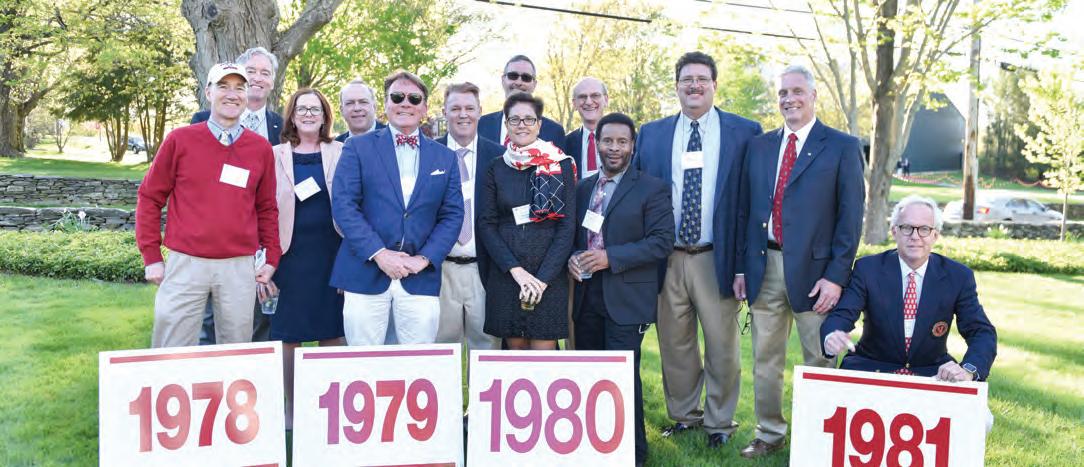
CelebratingReunion125were(L-R):ArthurDiaz‘78,BobMullarkey‘79,SusanMcKechnie‘79,BruceMikolajczak‘79, SamCargill‘79,DaveMeade‘79,MattFreund‘79,Monique(Lowery)Foster‘80,ToddGattoni‘79,MarkNorris‘79, DaveRamos‘79,DougRoach‘79,andEricFoster‘81.
1983
’83
Beth (Corcoran) Crompton and Dave Crompton ’84 are pleased to announce the arrival of their first grandchild. Quinn Savannah Johnson was born November 13, 2018 in Los Angeles, California. Baby and parents, Courtney and Nick, are all doing great!
’87
1987
Monique (Kapitulik) Wolanin wrote, “My husband Bruce (Pomfret’s Director of College Counseling) and I are the proud parents of three rapidly growing boys, as evidenced by our massive weekly grocery bill. Our oldest son/pilot Blake (17) graduated from Killingly High School in June. He will pursue Aviation Science in college, destination TBD. Ian (14) joined Pomfret’s Class of 2022 last fall — thirty-five years after his mother did in the fall of 1984 — YIKES! And Cal (11), who rounds out Team Wolanin, is a sixth grader at Pomfret Community
School. I work in fundraising/community engagement at our amazing community college (QVCC), which I take great pride in promoting. And speaking of promoting, if you’re looking for a great fall trail race, check out tacklethetrail.org. It starts in Pomfret and is open to individuals and teams! And yes, I am still running; thank you Marnie Keator and Mike Kennedy.”

Monique(Kapitulik)Wolanin’87andherfamily
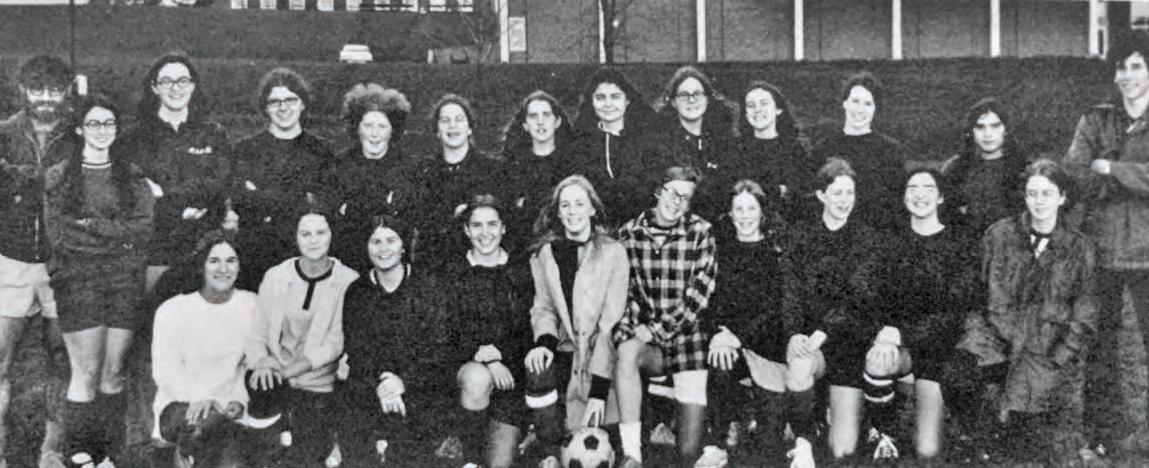
1970s Stories
Girls Soccer Kickoff
Sue Arsenault Leson, Class of 1972
Coach Merjian took fourteen girls in the first coeducational class at Pomfret and brought us together. He got us working as a team and created the belief within us that we were strong, smart, and talented — and that we were winners. None of us had played soccer before, but he didn’t let that dampen his enthusiasm. Day after day we would practice, our clumsy feet tripping over themselves, and never once did he get frustrated. Instead, he seized the successful moments, raised his hands to the sky (I suspect for God’s help), and cheered us on. What invaluable lessons in team spirit, cooperation, perseverance, and the winning attitude.

Stories
The Hot Tub
Walter Hinchman, Former Faculty
In the 1980s, student pranks were often quite imaginative and I had an advisee who perhaps topped them all. Tales of his effort have circulated around the halls of Pomfret for years and have almost achieved the status of an “urban legend.” I have often been asked if it really happened.
The young man in question, a senior at the time, lived in an arcade room and learned that beneath his room were tunnels which carried steam to the radiators in the dorms. He went to the maintenance shop, in those days where Parsons Lodge is today, and never locked or much supervised during the day. He borrowed some tools, including a saw, and returned to his room where, when the dorms were empty, he proceeded to cut a trap door in the floor of his room giving him entrance to the tunnel below. During regular hours the trap door was covered by an attractive rug. Another “borrowing” secured for him a plastic bin from the gym where it had been used for laundry. A little ingenuity and a hose enabled him to bring water from the faucet in the janitor’s closet, across the hall from his room, and so he was able to fill the
plastic bin. Electricity was no problem – an extension cord from the room above provided power for lighting and music. There you have it, a spa, or hot tub, located in the steam tunnel and known to only a very few.
That year was the only time in my Pomfret years that I did not attend graduation as I had a child graduating from college on the same day. My advisee had brought with him to graduation a note which he intended for me and which said essentially, “Check out my room later today.” The note went to a colleague who checked and blew the whistle on the project. Needless to say, the authorities were not pleased. After some negotiation, the student’s diploma was not rescinded, and he returned to school to do what he could to repair the damages, to return what he had “borrowed” and to pay for what he could not correct.
Now that this is in print all can know that it is not just a student fantasy, but that a hot tub really did exist in a dorm.
1980s

’89
Celebratingtheir30threunion,theClassof1989 are(frontrow,L-R):BillWiggins,DaryleBost,Chip Gengras,TaraPeters,Kelsey(Hubbard)Rollinson, James Newbold, Rod Gerdsen, Kirstin Travers, GenevieveSandberg-Diment;(backrow,L-R):Laurence Horvath,TedDeNapoli,BrianSmalley,NatePeirce, TobyMetcalf,AndrewSmith,Marina(Shields)Purcell, RichmanReinauer.Missingfromphoto:DawnCzaja andDavid“Tig”Tillinghast.
’90
1990
Congratulations to Derek Pratt and his wife, Diana, on the birth of their baby boy, Charles, in May 2018.
Ralph Koehring wrote, “I am in Amman, Jordan, where I entered my new tour as the Deputy Mission Director for USAID Jordan, the largest bilateral assistance program in USAID at $1.275 billion in annual assistance to the Government of Jordan. Our portfolio is expansive in water, education, health, economic development, and democracy and governance. On the family side, my oldest daughter, Josephine, is a freshman at King’s Academy here in Jordan. The Academy was the creation of His Majesty, King Abdullah II of Jordan, and is modeled after Deerfield Academy, where he graduated. It is the first of its type in the Middle East.”
’93
1989
’89
Liz (Scribner) Repetto reported, “After 18 years in Alaska, Maine has called me back home. My husband, Skip, and I, and our 10-year-old black lab Jupiter, have settled in Bethel, Maine, where the mountains, the trails, and the rivers will decorate our intentional blank canvas with colorful and diverse experiences. Maine family is very close on the coast, rather than four time zones and across the continent … delightful! Alaska friends and family feel far away, but we hope to show them that Maine really is a vacationland, and now they have an Alaskan connection on the East Coast! It sure feels great to be back amongst the people and places in this state that are rooted with history and story. Let the New England adventures begin!”
1993
Kari (Johnson) Whitney reported, “I recently graduated from UMass Medical School, Graduate School of Nursing, with my Masters as an adult gerontology nurse practitioner. I accepted a position as a palliative care nurse practitioner with Northern Light Home Care and Hospice in Bangor, Maine, and have been living and working there since October, 2018.”

CelebratingReunion125fromtheClassof1997were(L-R):KateRichardson,HadleyWeissRosen, andConnieMosherSyharat.
1995
’95 ’98
James Bartolomei and his wife, Suzanne, added a new member to his family — James “Henry” IV on October 13, 2017. In addition to his law practice, James is a co-founder of the Freedom Football League (FFL) based in Los Angeles. The FFL is the first professional sports league that the players and fans own the teams. The league was co-founded by 50 former NFL players, including Heisman Trophy winner Ricky Williams and Pro Football Hall of Famer Terrell Owens. The FFL is launching in Spring 2020, and plans to bring a team to the Hartford area, aptly named the Connecticut Underground, inspired by the region’s influence on historic social causes.
1998
Sarah Herklots is currently working as the co-director of purchasing and head of merchandising for Cambridge Naturals in Boston.
Sarah (Welch) Smith announced, “[My husband] Josh and I welcomed our baby boy, Langdon Smith, on September 20, 2018. My sister, Catherine (Welch) Carrington ’01, and her husband, Jamie, welcomed their first baby as well, George, two weeks before on September 3, 2018! Needless to say, the cousins have been having lots of fun together!”

(L-R):Chris’94andKakiBezamat,Nick’95andBarrettMettler,Washy’95andSarah Duke,andLulitaDuke’92andJohnReedspentafunThanksgivingDay(2017)together at Lulita’s house in Marin, California.

LangdonSmith,sonof Jamie & Sarah (Welch) Smith ‘98
1999
Congratulations to Jill (Bryant) Mayer, who was named a “40 Under Forty” award recipient by the Hartford Business Journal in August 2018. Jill is CEO of Bead Industries, Inc., a fifth-generation family business in Milford, Connecticut. She is the first female CEO of the company after 100 years of continuous operation. In addition to her work at Bead, Jill also serves on the board of advisors for the Center for Family Business at the University of New Haven, and is vice president of the New Haven Manufacturers Association and chair of the strategic planning committee.
Johnny Lorenz reported, “I have been working on licensing and legislation for the last three years with the Maine State Department of Health and Human Services. I currently have ten state and local licenses in my name to open a new business on Route 1 in Northport, Maine. I am registered with the Department of Agriculture as a legitimate farm, and I am getting a commercial bakery inspection soon to have fresh, made-to-order baked goods on site. I purchased a property on Rt.1, and I am just about to open. I was the third in the State of Maine to be passed by a local town planning board to open a retail medical marijuana establishment called Sweet Relief. They are behind me to open one of the first recreational marijuana stores in the state next year, and I own the property to avoid complications. There is no doubt that my time spent at Pomfret pulling all nighters on research and paperwork, has put me in the big ring today. The level of challenge that Pomfret prepares a student for in the real world can truly be quantified in this case. I am thankful for my time spent on the hilltop, and I invite anyone traveling north along Route 1 to swing in for a visit, or give me a call.”

2000
Greg and Molly (Graham) Hanson and their son, Bauer, were very excited to welcome their second child, John Birmingham “J.B.” Hanson, on March 8, 2018.
Congratulations to Alex Milligan, who was named one of the Top 40 Under 40 Tastemakers for 2018 by Wine Enthusiast Magazine.
Also, congratulations to Anthony Contrucci on being named to The Times of Northwest Indiana’s 20 Under 40 list in September 2018. Anthony is Vice President of Community Relations and Business Development for Centier Bank. He works closely with the communities Centier serves to integrate and align philanthropy, financial wellness, and increase exposure for business development opportunities across Centier’s footprint. He is also actively involved with nonprofits at a variety of levels, presenting to local rotaries and chambers and emceeing events throughout Indiana.
Johnny Feliciano announced, “My wife, Arin and I are happy to introduce our daughter: Fiona Lynn Feliciano. She was born in Boston, Massachusetts on August 20, 2018, weighing in at 7 pounds, 10 ounces. Fiona likes going for walks, dance parties and story time. We are looking forward to bringing her to the hilltop for the first time at the Class of 2000 20th reunion next year!”
For over six years, Rachel (Brewer) Beard has been living with her husband and three children (ages 6, 8, and 10) in Bangkok, Thailand where they regularly reconnect with Johnny Lorenz ’99 and his wife. As a writer and editor, she has completed a few feature film screenplays, published a book in collaboration with the Sri Lankan government, and is finishing up work on both a novel and a cookbook, to be published in 2019. She and her husband have also begun a Bangkok-based business in which they make and sell paleo/dairy-free chocolate, jerky, and kombucha. “Feel free to drop us a line if you ever find yourself venturing over to Thailand!”

2001
Congratulations to Emily and Cooper Hastings on the birth of their baby girl, Greer Virginia Hastings, on December 29, 2017.
Congratulations to Catherine (Welch) Carrington and her husband, Jamie, who welcomed their first baby, George Carrington, on September 3, 2018.


2002
Tamara (Froebel) Salkin wrote, “My husband and I welcomed a second baby boy, Abram Forest Salkin, on January 16, 2018. He joins big brother Benjamin who turned four in October. I cofounded a youth performing arts education company on the east end of Long Island called South Fork Performing Arts. We teach workshops in theatre and vocal performance and produce black box theatre performances.”
Julia Proctor and her husband Phil Aroneanu welcomed their daughter, Orli Aroneanu Proctor, into the world on March 26, 2018. She’s already a seasoned traveler and loves going on adventures. The family lives in Manhattan, where Phil works for the ACLU and Julia performs, as well as teaches, at Pace University and Clown Gym. ’01 Kerry&RyanConroy’01weremarriedonJune16, 2018inWashington,Connecticut.

Tamara(Froebel)Salkin’02withhertwosons,Benjamin and Abram, and husband, Mike
Orli Aroneanu Proctor

Stories
A Heavy Performance
Chip Lamb, Theater Director
In June 1994, Bob Sloat asked me if I would dress up as William Peck and speak to the students as part of Pomfret’s Centennial celebration. I had acted for enough school audiences to know this would not work. But I agreed to write a play about the founding of Pomfret if there was enough of a story.
O ver the next three months, I researched William Peck’s life at St. Mark’s and his subsequent departure to start a school of his own. With the help of faculty and staff at both schools and Nick Noble, a history teacher at the Fay School in Southborough, I was captivated by Peck’s audacity and tried to capture this spirit in an hour-long one-act. The play, “I’m a Master, I Believe,” was performed in Clark Chapel for the entire school on Founder’s Day. I played Peck; my wife, Susan, played Harriet Peck; and John Stebbins, husband of Academic Dean Janet Stebbins, played Joseph Burnett, founder of St Mark’s. There were also four students who played
a variety of roles, including a boy from the early years, Harry Williams, from whom it is believed Peck caught a fatal case of the flu.
The play appeared to be a great success and I was quickly approached by Sloatie to perform the play again the following spring for alumni weekend. I agreed. We gathered the same cast six months later and prepared for the performance. In the play, Peck scoops up a very sick Harry Williams and carries him to the infirmary. What I had underestimated is how much weight a fourth-form boy can gain in six months. When it came time to lift the student off the floor of the chapel, I couldn’t do it. There was a genuine moment of panic. With very real beads of sweat running down my face, I managed, just barely, to carry the boy off. William Peck’s health did indeed look compromised at that performance, but it had very little to do with acting.
1990s

Stories
One Louse, Many Lice
Hayden Clarkin, Class of 2013
In December of 2012, Pomfret had a lice outbreak. Almost everyone got lice, besides me and a handful of other people. Coconut oil, hair nets, and tea tree shampoo was used by everyone. We had to go home to Christmas Vacation because of it.
One of the most amazing things was that many Pomfret students and faculty volunteered to shampoo infected people’s hair for hours. It was one of the nicest acts I had seen at my time at Pomfret, that people would take the time to help people and comfort them as they felt embarrassed.
2000s
2003
Alex and Katie (Bell) Bues welcomed their daughter Carter Elizabeth “Cece” Bues in March of 2017. After two years in Durham, North Carolina and two years in Birmingham, Alabama, they are thrilled to have returned to Connecticut. They’re living in New Canaan and looking forward to reconnecting with classmates!
Congratulations to Bill Army and the rest of the company of the Broadway musical The Band’s Visit for winning 10 Tony Awards on June 10, 2018, including Best Musical!
Molly (Shuster) Otocka and Eddie Otocka ’02 welcomed their first baby, Abigail, on July 23, 2018 weighing in at 7 pounds, 6 ounces. Molly wrote, “Thank you to Pomfret for bringing us together all those years ago!”
Laura (Keeler) Pierce has been busy launching Keeler & Co., her boutique residential interior design firm in Boston, and is especially grateful for her many Colby clients. She is currently working on projects in Connecticut, Massachusetts and Maine, with a storefront coming in 2020!


CeceBues,daughterofAlex&Katie(Bell)Bues’03

CongratulationstoStacyCollins‘03andMelissaCollins (center)whoweremarriedinSantorini,GreeceonAugust20, 2018,withKeithandMaren(Schirra)Fleming‘02inattendance.

CelebratingReunion125fromtheClassof2003were(L-R):Katie(Bell)Bues,Kendra(Seaward)Sumner,Laura(Keeler)Pierce,Lia (VonOertzen)Roll,andSarah(Ortiz-Elejalde)Vazquez.Missingfromphoto:SaleemAhmedandChelsea(Weiss)Baum.
’03
AbigailSwiftOtocka
’04
2004
Etienne Vazquez and his wife Sarah ’03 welcomed their third child, Marie Evers Elejalde Vazquez. Big brother Lion and big sister Lucie love her a lot and have decided to keep her.
Congratulations to Katherine Seltzer, who was married to Chad Hoffman on June 30, 2018 in North Stonington, Connecticut. Pomfret alumni in attendance were family and friends including Angela (Malerba) Werry, aunts Linnea (Corwin) Elrington ’80 and Karen (Corwin) Mook ’75, uncle James Corwin ’72, and cousins Casey ’09, Lucas ’13 and Chloe Gillespie ’14
Congratulations to Elizabeth and Connor Tubridy, who happily welcomed baby William Miles Enderle Tubridy into the world on September 17, 2018 in Denver, Colorado.
Michael Roof wrote, “I am a fourth generation plastering contractor that specializes in historic restoration of mostly highend residential homes throughout the Boston area. I have been married since 2005 to my wife Elizabeth, and we have three children: Ainsley (12), Michael III (11), and Emily (5). I was the assistant hockey coach for our hometown for four years, and for the past three years I have been the head coach of my son’s team (he is a pee-wee goalie). I played varsity hockey at Pomfret for my two years I was there as well as being the captain of the football team. Some of my best memories are from Pomfret and I learned more in my two years there than any other years combined. The people I was able to meet and network with while attending Pomfret has forever changed the way I approach just about everything I do on a day-to-day basis. My path hasn’t been the most conventional, yet in my opinion still successful and fulfilling nonetheless. I consider myself extremely fortunate to have known the faculty, staff and fellow students while attending Pomfret.”

RebeccaCoakley‘04wasmarriedtoKacieLewinonOctober27,2018.KimLaffin,wifeofKatelynnLaffin‘02,officiatedthe ceremony.Weddingguestsincluded(firstrow,L-R):Melissa(Wigmore)Sawartzky‘03,KimLaffin,Kacie(Lewin)Coakley,Katelynn Laffin‘02;(secondrow,L-R):MarkSawartzky,CarySimms,RebeccaCoakley‘04,DawnRenda,facultymemberRebBrooks,Dolph Clinton‘92,andfacultymembersArtandMarthaHorstP‘13,‘15,‘19,‘22,‘22.



EtienneVazquez‘04withhischildren Marie, Lion, and Lucie
2005
From notebook sketch to shelf, Chris Martin played a large role in the design and development of the Ninja Foodi pressure cooker/crisper. He and his engineering and design team were all very excited about the end result and its release in the fall of 2018! SeungUn Ham was accepted to Kakao, one of the most popular companies in Korea, as iOS developer. He began working there in November 2018.

MalloryJaffe‘05wasmarriedtoRobertSorkinonMay 27,2018inLosAngeles.Sharinginthecelebration werefellowPomfretalumnae(L-R):LilyBarrett‘05, Mallory,AudreyWilson‘05andElizabethSadler‘05. MichaelRoof‘04andhisfamily
Chad Hoffman and Katherine Seltzer ‘04
Julia Field reported, “On August 18, 2018 Sean Driscoll ’06 and I were married at St. Columba’s Church in Middletown, Rhode Island, with reception following at Bailey’s Beach Club in Newport, Rhode Island. We had a few other Pomfret alumni with us: Ryan Joyce ’06 and Else Ross were in the wedding and Else’s fiancé Brady Griffin ’06 was also there, along with Sean’s sister Katelyn Driscoll ’08 and cousin Dan Driscoll and his wife Dory, who both worked at Pomfret. Sean’s brother Teddy Driscoll ’11 and cousin David Driscoll ’04 were the co-best men.” ’06
2006
Ryan Joyce announced, “My wife Pamela and I welcomed our second child, Bobby James Joyce, to the family on June 14, 2018. His big sister, Davie Joanne Joyce, couldn’t be happier! Sean Driscoll is his godfather.”
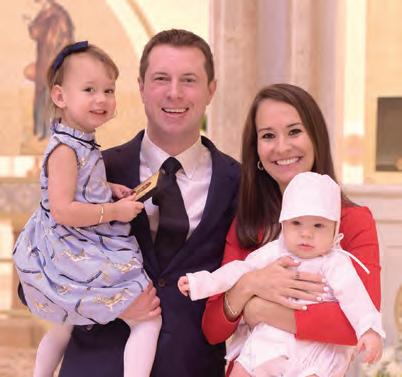

CongratulationstoEmilyDetmer‘07(center) whowasmarriedtoDentonTayloronMay12, 2018atherfamily’shomeinDenver,Colorado. FormerfacultymemberSaraWoodandChris Golden ‘07 were in attendance.
’07
2007
Congratulations to Bryan Heckendorf for his work to optimize the pod design for the U.S. Olympic team’s luge sleds. His team developed a computerized tool that enabled design for individuals to allow more comfort to the athlete and better aerodynamics. This enabled modern manufacturing processes to be applied, which reduced build time per pod from many months to a week or two. U.S. Olympian Chris Mazdzer won a silver medal in the men’s singles luge event in the 2018 games. This was the first ever U.S. medal for the event.

MelissaStuart‘07andJeremyRogalskiwere marriedatWequassettResortandGolfClub inHarwich,MassachusettsonJuly29,2018.
RyanJoyce‘06andhisfamily

CelebratingtheweddingofSeanDriscoll‘06andJuliaField‘07(center)were(L-R):TeddyDriscoll‘11,KatelynDriscoll‘08, ElseRoss‘07,andBradyGriffin‘06.Photocredit:BrianSagerPhotography

CelebratingReunion125fromtheClassof2011were(L-R):AndrewRobinson,DavidSt.Lawrence,JamieSamociuk,LaurenDaly, JJAhmed,JackWheatley,AshleyNewhall,EmilyCollins,andShaneDunphy.
2009
Sade Porter recently began a doctorate program in school psychology at Rutgers University Graduate School of Applied and Professional Psychology in New Brunswick, New Jersey.
Eddie Ross reported, “[My wife] Courtney and I welcomed our daughter, McKenna Leigh Ross, into the world on July 28, 2018. The three of us are living in North Carolina, where I’m stationed with a helicopter squadron, and Courtney is running her marketing company.”

EddieRoss‘09withhiswife,Courtney,andtheirbaby daughterMcKenna

CelebratingReunion125fromtheClassof2013were(L-R):GeoffShort,ChrisPease, EthanUfland,MalcolmChace,BobbyKelsey,PeterReimer.Missingfromphoto:ShandyChen, DanKellaway,andLianaTherrien.
2013
’13
Congratulations to Ollie Adekanbi, who received a certificate from the Massachusetts House of Representatives on March 17, 2018 in recognition of her contributions towards advocating for continued research and advancements of sickle cell disease, and on the occasion of receiving the Greater Boston Sickle Cell Disease Association scholarship award. Ollie graduated from Northeastern University in May 2018 and plans to pursue her Ph.D. in immunology.
’14
2014
Ben Rumrill was the recipient of a research fellowship from the NASA Connecticut Space Grant Consortium. A student at Eastern Connecticut State University where he majors in biology, Ben is using the fellowship to support his research titled, “The Effect of Microgravity on the Growth and Function
of Neural Cells.” As scientists have discovered that space flight can lead to cognitive deficits due to the inhibition of neural stem cell differentiation, Ben’s research aims to test for changes in the production of neural stem cells’ ability to replicate and differentiate when grown in simulated microgravity (weightlessness) when compared to normal conditions. He hypothesizes that microgravity experienced during space flight impairs the ability of neural stem cells to reproduce and differentiate, leading to the cognitive deficits found in astronauts.
’15
2015
Abby Horst, a junior on the Wesleyan University women’s lacrosse team, is a 2018 All-American and All-NESCAC First Team selection. She was named NESCAC Women’s Lacrosse Player of the Week on April 29, 2019 and IWLCA Division III Offensive National Player of the Week on May 1, 2019.

Celebratingtheir5thReunion, alumnirepresentingTheGreat Class of 2014 are (L-R): Dana Diaz, Ambra Fisser, Scott Guo, and Michael Weaver. Over 40 classmates attended!
Network
Connect
Events

Volunteer
Jobs
News
Faculty/Staff News
It’s been a baby boom on the Hilltop! Congratulations to these faculty members on their newest additions:
• Kara Burke [Spanish, 2009–2011] and Patrick Burke [Director of Faculty Mentoring, 2010–present] announced the birth of their twins! Zoe Demetra Burke and Conor Stone Burke were born on April 27, 2018.
• Mariona Pérez Oliva [Spanish, 2015–2019] and her husband Jaime announced the arrival of their baby daughter, Noa Tarrós Pérez, on August 6, 2018.
• John & Micaela Dangelo [Science, 2013–present] welcomed Ezra John Dangelo on October 25, 2018.
• Quinn Rose [History, 2014–2019] and Tim Rose [Chemistry, 2015-2019] welcomed their son, James Otto Rose, on May 5, 2019.
Former faculty members Tim Peck ’00 [Contemporary Music, 2005–2018] and Melissa Wyse [English/Writer in Residence, 2016–2018] were married on August 12, 2018 in a private ceremony in Brooklyn, NY. Currently Tim is working as a professional musician and educational consultant, and Melissa has a new book forthcoming from Chronicle Books next year.

Former faculty member Don Hinman [English, 1965–1977] wrote, “I was at Pomfret for eleven years in the mid-1970s and 80s through very exciting and eventful times: wonderful faculty and staff, early years of coeducation, challenges that made teaching and school mastering important and stimulating. All of us have names that we remember with fondness and respect. Let me add one that might have escaped your memory: school doctor David Bates.”
Congratulations to former Headmaster Jay Milnor [1961–1973], who was presented with the French Legion of Honor Medal on January 9, 2019 for his service in France during World War II.

and Zoe Burke

Conor
EzraDangelo
MelissaWyseandTimPeck’00
Miriam (Jamron) Baskies
(Simmons)
Joanna Kentoudakis
Hadley (Weiss) Rosen
Toyin Moses
Livia (Skelly-Dorn) Roustan
(Boardman) Duerr
Hilary (Gerson) Axtmayer
Caitlin (Rogers) Connelly
Wendy (Smith) Scarisbrick
Christina (Galanti) Dickson
Jo Anna (Galanti) Fellon
John Lindsey
Colton
Chris
Bill Wentworth
Saleem Ahmed
Chelsea (Weiss) Baum
Laura (Keeler) Pierce
Chris Pike
Mackie (Pilsbury) Spadaccini
Poon Watchara-Amphaiwan
(Gilmore) Castiglione
Hillary (Ross) Charalambous
Caroline (McLoughlin)
Maryam Hayatu-Deen Greg
(Winogradow) Munno
In Memoriam




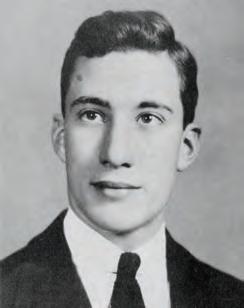
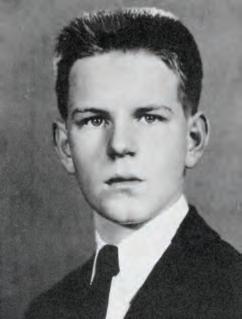


Stephen D. Jeffrey ’44 December 24, 2018
Robert H. Sayre IV ’44 January 7, 2018
Donald K. Brush ’47 January 1, 2019
Seth B. French, Jr. ’37 March 8, 2018
David Z. Bailey ’40 November 14, 2018
Francis O. Lathrop, Jr. ’41 March 5, 2018
G. Stewart Hoagland ’41 August 27, 2018
Roswell B. Perkins ‘43 March 10, 2019

Benjamin C. Allen ’48
January 25, 2018

Peter R. Ransom ’50 May 25, 2018

William D. Shew, Jr. ’52 March 18, 2019

Douglas J.S. Gordon ’48 January 7, 2018

A. Bryan ’51 February 13, 2018

Edgar N. Harland, Jr. ’53 January 28, 2018

July 4, 2018

January 23, 2019

C. Parker, Jr. ’54 October 21, 2018

September

June

November 17, 2018
Marsh
Andrew W. Bingham ’52
Peter B. Burnham ’52
24, 2018
David M. Phillips ’48
Stuart J. Bracken ’49
9, 2018
Edward
Samuel Thoron ’57
In Memoriam

’58

Thomas P. Cutler ’63 October 23, 2018

’59

Merritt L. Armstrong ’67 January 24, 2019

John R. Hersey, Jr. ’61 May 31, 2018

David K. Storrs ’62 March 3, 2019
Selden K. Griffen III ’67 February 23, 2018
Mark D. Bramble ’69 July 10, 2018
To request a printed copy of full detail alumni obituaries, call the Advancement Office at 860-963-6129.

June





June

June
August
Janet Arvonen Kniffin ’70
10, 2018
Bradley F. Lopez ’03
13, 2018
Scott L. Steele ’71
March 24, 2018
Ann Jones Fisher ’75
February 16, 2019
Joseph P. Muldoon, Jr. ’77
May 21, 2018
N. Kwaku Offei-Addo ’10
21, 2018
Ethel “Smoke” Twichell P ’67
9, 2018 (Wife of former headmaster David Twichell)
Caryn J. Columbo ’80 March 28, 2019
The Clock Tower
Horology (n) the science of measuring time. (n) the art of making timepieces.

The clock was manufactured in the early part of the 20th century by E. Howard & Co. and was donated to the School by Stephen Peabody (father of George Peabody ’09 and grandfather of George Peabody Jr. ’32) in 1906. It was put into operation on April 12, 1907.
The heart of the clock tower is a weight-driven, pendulum-regulated mechanical timepiece registered with the National Association of Watch and Clock Collectors, a worldwide organization dedicated to the preservation and education of horology and horological artifacts. Who knew?
The bell, which tolls the number of hours, on the hour, was cast by Meneely Bell Company in 1906. The bronze tocsin weighs 350 pounds and measures 26 inches in diameter.

The clock took a licking, but keeps on ticking! Much of this is credited to longtime faculty member and Pomfret’s unofficial handyman-in-residence Ben Morgan ’53. Every week (like clockwork), Ben climbed the narrow staircase high into the tower to wind the clock. In 1988, assisted by Jonathan Larrabee ’89, Ben even rebuilt the inner mechanism of the clock, saving the School significant repair costs.

At 10:20 p.m. on May 13, 1975, the clock tower was struck by a bolt of lightning, resulting in a spectacular explosion that tossed the clock’s mechanism to the ground four stories below. The class of 1975 was quick to take credit for the destruction, erecting a sign in the roped-off area that read “You ain’t seen nuthin’ yet!”
In November 2018, representatives from Peter Nunes Clock Restoration disassembled the 113-year-old timepiece and removed it from the clock tower as part of a new restoration effort spearheaded by Jay Simpkins ’68 and funded by the Class of 1968. Once restored, the old mechanical timepiece will go on display in Jahn Reading Room. An electric timepiece now powers the old tower dials and bell, and the tintinnabulation is once again heard across campus.
Gatherings
STAY CONNECTED
Don’t miss the next gathering near you! Look for our Upcoming Events newsletter.
Atlanta, Georgia


125th Reception
MAY 5, 2018
(L-R): Hanifa McGaffie ’92, Sarah Howie ’09, Joan (Fiore) Collins ’91, Telena Bolding ’87, and Dave Woodrow ’64 were among the guests in attendance in Atlanta. Missing from photo: David Marks ’99.
Photo by JonesieD Photo
125th Reception
FEBRUARY 5, 2019
(L-R): Dave Woodrow ’64 and his wife Cindy, Sarah Howie ’09, Samantha (Lampert) Naik ’99, Rohan Khatu ’15, Lawrence Ough ’75, Assistant Head for Institutional Advancement Melissa Bellanceau, Barrett (Coker) Krise ’93, Head of School Tim Richards P ’15
New York, NY



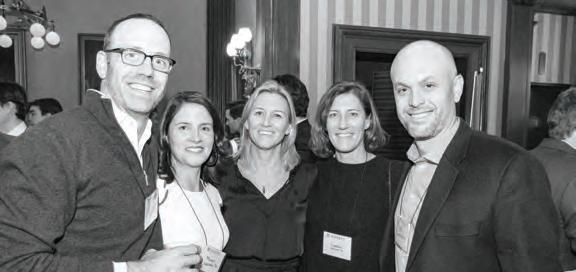

Red Sox vs Yankees
JUNE 29, 2018
Pomfret alumni and parents at the Red Sox vs. Yankees baseball game at Yankee Stadium
Holiday Reception
DECEMBER 4, 2018
Sam Cargill ’79 (left) and Trustee Bob Mullarkey ’79, P ’10
Holiday Reception
DECEMBER 4, 2018
(L-R): Class of 1982 mates James Snyder, Luiz Cruz, Mike Zurbrigen, Joey Moffitt, and Trustee Mark Cohen
Holiday Reception
DECEMBER 4, 2018
(L-R): Class of 1991 mates Christopher Victory, Frances (Lumpkin) Webster, Samantha (Jones) O’Brien, Courtney (Hallock) McGuinness, and Jesse Lawrence
Holiday Reception
DECEMBER 4, 2018
(L-R): Zach Perreten ’09, Sarah Howie ’09, Katie Kramer ’09
Connecticut


Tennis in New Canaan
AUGUST 16, 2018
(L-R): Paul Fowler ’64, Alex, Cece, and Katie (Bell) Bues ’03, Vip van Voorhees ’64
Paddle Tennis at New Canaan Field Club, New Canaan
NOVEMBER 9, 2018
(L-R): Jeff & Mary Kroll P ’20, Vip Van Voorhees ’64, Meg Campbell P ’01, ’07, Meg Hecker ’10, Bill Hecker P ’10, Joey Moffitt ’82, Paul Fowler ’64, Katie (Bell) Bues ’03 and Alex Bues

Woodruff Winter Benefit Hockey Game, Pomfret
JANUARY 26, 2019
Front row, (L-R): Ryan Scully ’08, Annie O’Sullivan (faculty), Rob Lemelin ’02, Ray Zeek ’11, Charlie Cole ’75, Chris Pease ’13, Bruce Mikolajczak ’79, Steve Woodruff ’77, Greg Osborne ’03, Jesse Walker ’02, Brad Woodruff, Bryan Heckendorf ’07, Ben Woodruff; back row, (L-R): Katie Duglin ’01 (faculty), Steve Cargill ’08, Xander Jones ’04, Tucker Prudden (faculty), Todd Matthew (faculty), Willie Cole ’81, Ethan Ufland ’13, Connor Quinn ’11, John Cunningham ’13, John Fiske ’53, Eric Weichselbaumer P ’19, Matt Goldblatt ’00, Louisa Jones P ’04 (faculty), Ted Holmes P ’22, Head of School Tim Richards P ’15
Massachusetts


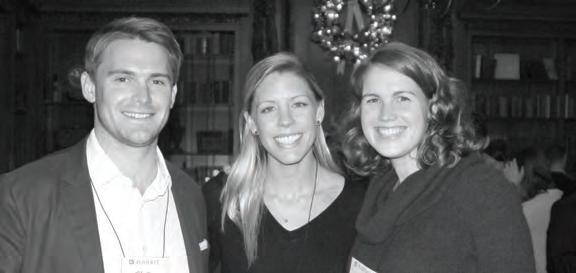


Paddle Tennis at Myopia Hunt Club
NOVEMBER 2, 2018
(L-R): Linda (Bryan) Brenske ’83, Advancement Officer Allison Koehler, Ollie & Elise Wolcott P ’18, Dick Fates ’63, Advancement Officer Louisa Jones P ’04, Fedor Smith ’95, Chad Cooper ’96, Paul Schauder P ’19, Mike Newton ’96
Boston Holiday Reception
DECEMBER 10, 2018
(L-R): Michelle with Sarah Herklots ’98, Kate Richardson ’97, Genevieve Richardson ’99
Boston Holiday Reception
DECEMBER 10, 2018
(L-R): Steve Cargill ’08, Amy Toegemann, Sarah Evans ’08
Boston Holiday Reception
DECEMBER 10, 2018
(L-R): Former faculty Jeremiah Jones P ’04, Paul Fowler ’64, Rick Levin ’69, John Fiske ’53, Richard Bassett P ’22, Christina Landshut, Dick Fates ’63
Boston Holiday Reception
DECEMBER 10, 2018
(L-R): Mark Kozlowski ’14, Nate Kremer ’14, Olivia Kremer ’17
Washington, DC

Mexico

Holiday Reception
DECEMBER 6, 2018
Alumni at the home of Michael Petty ’67 and Valerie Tripp to celebrate the holiday season
Mexico
JANUARY 13, 2019
Head of School Tim Richards P ’15 and Melissa Bellanceau, Assistant Head for Institutional Advancement, met with current and prospective families in Mexico in January 2019
Asia
In November 2018 Head of School Tim Richards and Anne Richards P ’15, with Assistant Head for Institutional Advancement Melissa Bellanceau, traveled to Asia to meet and gather with parents and alumni in Thailand, China, Hong Kong, Singapore, and Japan.



Thailand
Melissa Bellanceau and Anne and Tim Richards P ’15 having dinner with alumni
Shanghai
Melissa Bellanceau and Anne and Tim Richards P ’15 (center) with parents Zhenyu Zhang & Haiqing Lu P ’22, Terry Xia & Eva Zhao P ’22, and Wei Lan & Hong Pan P ’22
Shanghai
With parents in Shanghai, China






































Beijing





With parents in Beijing, China


Beijing
(L-R): Yundong Zhang P ’21, Melissa Bellanceau, Tim and Anne Richards P ’15, and Shiping Qin P ’21
Japan





(L-R): Tiffany Ding P ’21, ’22, Melissa Bellanceau, Anne and Tim Richards P ’15, Charles Xue P ’21, ’22 and guest
PARTING SHOT
Pomfret School, Class of 1907


Change Service Requested










































